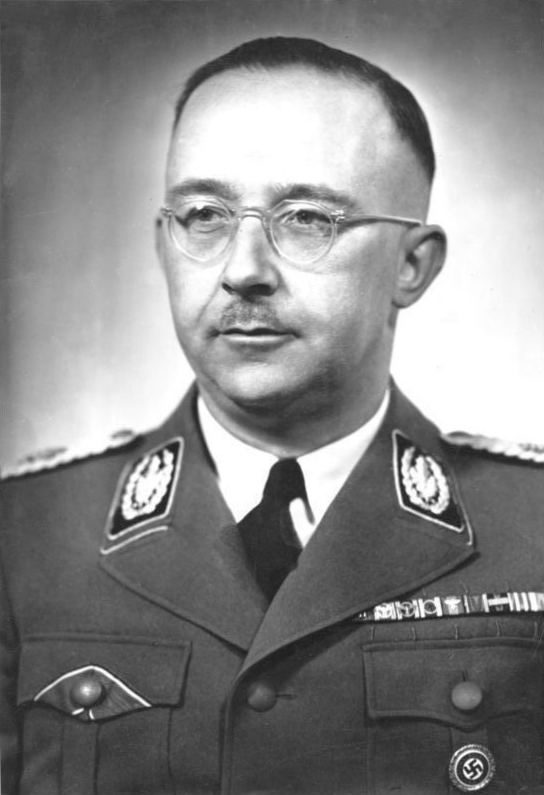
ハインリヒ・ヒムラー
Heinrich Luitpold Himmler, 1900-1945

★親衛隊全国指導者、全ドイツ警察長官、ドイツ民族強化担当実務長官などを務め、強制収容所
の収容者で医学実験を積極的におこなうことを奨励した。その過程で50万人を超える奴隷
労働者を軍や軍需生産設備などに売り渡した。警察・親衛隊組織などの絶対権力を掌握したことによって、ナチの数々の残虐行為の無比の責任者となった(→「ペーパークリップ作戦名簿」より)。
★ヒムラー伝 https://en.wikipedia.org/wiki/Heinrich_Himmler
より
| Heinrich
Luitpold Himmler
(German: [ˈhaɪnʁɪç ˈluːɪtpɔlt ˈhɪmlɐ] ⓘ; 7 October 1900 – 23 May 1945)
was a German politician who was the 4th Reichsführer of the
Schutzstaffel (Protection Squadron; SS), a leading member of the Nazi
Party of Germany, and one of the most powerful men in Nazi Germany,
primarily known for being a main architect of the Holocaust. As a member of a reserve battalion during the First World War, Himmler did not see active service or combat. He joined the Nazi Party in 1923 and the SS in 1925, and in 1929 Adolf Hitler appointed him Reichsführer-SS. Over the next sixteen years, Himmler developed the SS from a 290-man battalion into a million-strong paramilitary group. He was known for good organisational skills and for selecting highly competent subordinates, such as Reinhard Heydrich in 1931. From 1943 onwards, he was both Chief of the Kriminalpolizei (Criminal Police) and Minister of the Interior, overseeing all internal and external police and security forces, including the Gestapo (Secret State Police). He also controlled the Waffen-SS, the military branch of the SS. Himmler's interest in occultism and Völkisch topics influenced the development of the racial policy of Nazi Germany, and he also incorporated esoteric symbolism and rituals into the SS. He was the principal overseer of Nazi Germany's genocidal programs, forming the Einsatzgruppen and administering extermination camps. In this capacity, Himmler directed the killing of some six million Jews, between 200,000 and 500,000 Romani people, and other victims. A day before the launch of Operation Barbarossa, Himmler commissioned the drafting of Generalplan Ost, which was approved by Hitler in May 1942 and implemented by the Nazi regime, killing approximately 14 million people, mostly Polish and Soviet citizens. Late in the Second World War, Hitler briefly appointed Himmler as military commander and later Commander of the Replacement (Home) Army and General Plenipotentiary for the administration of the entire Third Reich (Generalbevollmächtigter für die Verwaltung). Specifically, he was given command of the Army Group Upper Rhine and the Army Group Vistula. After Himmler failed to achieve his assigned objectives, Hitler replaced him in these posts. Realising the war was lost, Himmler attempted to open peace talks with the western Allies without Hitler's knowledge, shortly before the end of the war. Hitler learned of this, dismissed him from all his posts in April 1945, and ordered his arrest. Himmler attempted to go into hiding but was detained and arrested by British forces and died by suicide in British custody on 23 May 1945. |
ハインリヒ・ルイトポルト・ヒムラー(ドイツ語: ドイツ語:
[ˈhaɪç ˈluːɪɔɪtplt ˈɪ ˘ɐ; 1900年10月7日 -
1945年5月23日)は、ドイツの政治家であり、シュッツシュタッフェル(保護隊)第4代帝国総統であった;
ナチス・ドイツ党の主要メンバーであり、ナチス・ドイツで最も権力を持った人物の一人で、主にホロコーストの立役者として知られる。 ヒムラーは第一次世界大戦中、予備大隊に所属していたため、現役兵として戦闘に参加することはなかった。1923年にナチ党に、1925年にSSに入党 し、1929年にアドルフ・ヒトラーからSS総統に任命された。それから16年間、ヒムラーは親衛隊を290人の大隊から100万人規模の準軍事組織へと 発展させた。ヒムラーは組織作りに長け、1931年にはラインハルト・ハイドリヒのような有能な部下を選んだことで知られる。1943年以降、彼は刑事警 察長官と内務大臣を兼任し、ゲシュタポ(秘密国家警察)を含む内外のすべての警察・治安部隊を監督した。また、親衛隊の軍事部門であるヴァッフェンSSも 統括した。 ヒムラーのオカルティズムとヴェルキッシュの話題への関心は、ナチス・ドイツの人種政策の展開に影響を与え、SSにも秘教的象徴主義と儀式を取り入れた。 彼はナチス・ドイツの大量虐殺計画の主要な監督者であり、アインザッツグルッペンを結成し、絶滅収容所を管理した。ヒムラーはこの立場で、約600万人の ユダヤ人、20万人から50万人のロマ人、その他の犠牲者の殺害を指揮した。この計画は1942年5月にヒトラーによって承認され、ナチス政権によって実 行され、ポーランド人とソ連人を中心に約1400万人が殺害された。 第二次世界大戦後期、ヒトラーはヒムラーを一時的に軍司令官に任命し、のちに補充(本国)軍司令官兼第三帝国全体の管理総指揮官 (Generalbevollmächtigter für die Verwaltung)に任命した。具体的には、ライン上流軍集団とヴィスワ軍集団の指揮を任された。ヒムラーが与えられた目標を達成できなかったため、 ヒトラーはヒムラーに代わってこれらの役職に就いた。敗戦を悟ったヒムラーは、終戦直前、ヒトラーの目を盗んで西側連合国との和平交渉を開始しようとし た。これを知ったヒトラーは1945年4月、ヒムラーをすべての役職から解任し、逮捕を命じた。ヒムラーは潜伏を試みたが、イギリス軍に拘束・逮捕され、 1945年5月23日にイギリス軍の拘束下で自殺した。 |
Early life Himmler as a child[2] Heinrich Luitpold Himmler was born in Munich on 7 October 1900 into a conservative middle-class Roman Catholic family. His father was Joseph Gebhard Himmler (1865–1936), a teacher, and his mother was Anna Maria Himmler (née Heyder; 1866–1941), a devout Roman Catholic. Heinrich had two brothers: Gebhard Ludwig (1898–1982) and Ernst Hermann (1905–1945).[3] Himmler's first name, Heinrich, was that of his godfather, Prince Heinrich of Bavaria, a member of the royal family of Bavaria who had been tutored by Himmler's father.[4][5] He attended a grammar school in Landshut, where his father was deputy principal. While he did well in his schoolwork, he struggled in athletics.[6] He had poor health, suffering from lifelong stomach complaints and other ailments. In his youth he trained daily with weights and exercised to become stronger. Other boys at the school later remembered him as studious and awkward in social situations.[7] Himmler's diary, which he kept intermittently from the age of 10, shows that he took a keen interest in current events, dueling, and "the serious discussion of religion and sex".[8][9] In 1915, he began training with the Landshut Cadet Corps. His father used his connections with the royal family to get Himmler accepted as an officer candidate, and he enlisted with the reserve battalion of the 11th Bavarian Regiment in December 1917. His brother, Gebhard, served on the western front and saw combat, receiving the Iron Cross and eventually being promoted to lieutenant. In November 1918, while Himmler was still in training, the war ended with Germany's defeat, denying him the opportunity to become an officer or see combat. After his discharge on 18 December, he returned to Landshut.[10] After the war, Himmler completed his grammar-school education. From 1919 to 1922, he studied agriculture at the Munich Technische Hochschule (now Technical University Munich) [11] following a brief apprenticeship on a farm and a subsequent illness.[12][13] Although many regulations that discriminated against non-Christians—including Jews and other minority groups—had been eliminated during the unification of Germany in 1871, antisemitism continued to exist and thrive in Germany and other parts of Europe.[14] Himmler was antisemitic by the time he went to university, but not exceptionally so; students at his school would avoid their Jewish classmates.[15] He remained a devout Catholic while a student and spent most of his leisure time with members of his fencing fraternity, the "League of Apollo", the president of which was Jewish. Himmler maintained a polite demeanor with him and with other Jewish members of the fraternity, in spite of his growing antisemitism.[16][17] During his second year at university, Himmler redoubled his attempts to pursue a military career. Although he was not successful, he was able to extend his involvement in the paramilitary scene in Munich. It was at this time that he first met Ernst Röhm, an early member of the Nazi Party and co-founder of the Sturmabteilung ("Storm Battalion"; SA).[18][19] Himmler admired Röhm because he was a decorated combat soldier, and at his suggestion Himmler joined his antisemitic nationalist group, the Bund Reichskriegsflagge (Imperial War Flag Society).[20] In 1922, Himmler became more interested in the "Jewish question", with his diary entries containing an increasing number of antisemitic remarks and recording a number of discussions about Jews with his classmates. His reading lists, as recorded in his diary, were dominated by antisemitic pamphlets, German myths, and occult tracts.[21] After the murder of Foreign Minister Walther Rathenau on 24 June, Himmler's political views veered towards the radical right, and he took part in demonstrations against the Treaty of Versailles. Hyperinflation was raging, and his parents could no longer afford to educate all three sons. Disappointed by his failure to make a career in the military and his parents' inability to finance his doctoral studies, he was forced to take a low-paying office job after obtaining his agricultural diploma. He remained in this position until September 1923.[22][23] Nazi activist Himmler joined the Nazi Party on 1 August 1923,[24] receiving party number 14303.[25][26] As a member of Röhm's paramilitary unit, Himmler was involved in the Beer Hall Putsch—an unsuccessful attempt by Hitler and the Nazi Party to seize power in Munich. This event would set Himmler on a life of politics. He was questioned by the police about his role in the putsch but was not charged because of insufficient evidence. However, he lost his job, was unable to find employment as a farm manager, and had to move in with his parents in Munich. Frustrated by these failures, he became ever more irritable, aggressive, and opinionated, alienating both friends and family members.[27][28] In 1923–24, Himmler, while searching for a world view, came to abandon Catholicism and focused on the occult and in antisemitism. Germanic mythology, reinforced by occult ideas, became a religion for him. Himmler found the Nazi Party appealing because its political positions agreed with his own views. Initially, he was not swept up by Hitler's charisma or the cult of Führer worship. However, as he learned more about Hitler through his reading, he began to regard him as a useful face of the party,[29][30] and he later admired and even worshipped him.[31] To consolidate and advance his own position in the Nazi Party, Himmler took advantage of the disarray in the party following Hitler's arrest in the wake of the Beer Hall Putsch.[31] From mid-1924 he worked under Gregor Strasser as a party secretary and propaganda assistant. Travelling all over Bavaria agitating for the party, he gave speeches and distributed literature. Placed in charge of the party office in Lower Bavaria by Strasser from late 1924, he was responsible for integrating the area's membership with the Nazi Party under Hitler when the party was re-founded in February 1925.[32][33] That same year, he joined the Schutzstaffel (SS) as an SS-Führer (SS-Leader); his SS number was 168.[26] The SS, initially part of the much larger SA, was formed in 1923 for Hitler's personal protection and was re-formed in 1925 as an elite unit of the SA.[34] Himmler's first leadership position in the SS was that of SS-Gauführer (district leader) in Lower Bavaria from 1926. Strasser appointed Himmler deputy propaganda chief in January 1927. As was typical in the Nazi Party, he had considerable freedom of action in his post, which increased over time. He began to collect statistics on the number of Jews, Freemasons, and enemies of the party, and following his strong need for control, he developed an elaborate bureaucracy.[35][36] In September 1927, Himmler told Hitler of his vision to transform the SS into a loyal, powerful, racially pure elite unit. Convinced that Himmler was the man for the job, Hitler appointed him Deputy Reichsführer-SS, with the rank of SS-Oberführer.[37] Around this time, Himmler joined the Artaman League, a Völkisch youth group. There he met Rudolf Höss, who was later commandant of Auschwitz concentration camp, and Walther Darré, whose book The Peasantry as the Life Source of the Nordic Race caught Hitler's attention, leading to his later appointment as Reich Minister of Food and Agriculture. Darré was a firm believer in the superiority of the Nordic race, and his philosophy was a major influence on Himmler.[34][38][39] |
生い立ち 幼少期のヒムラー[2] ハインリヒ・ルイトポルト・ヒムラーは1900年10月7日、ミュンヘンで保守的な中流階級のローマ・カトリックの家庭に生まれた。父は教師のヨーゼフ・ ゲプハルト・ヒムラー(1865-1936)、母は敬虔なローマ・カトリック信者のアンナ・マリア・ヒムラー(旧姓ヘイダー、1866-1941)であっ た。ハインリッヒには2人の兄弟がいた: ゲバルト・ルートヴィヒ(1898-1982)とエルンスト・ヘルマン(1905-1945)であった[3]。 ヒムラーのファーストネームであるハインリヒは、名付け親であるバイエルン王家のハインリヒ公の名前であり、ヒムラーの父親が家庭教師をしていた。学業は 優秀であったが、陸上競技では苦戦を強いられた[6]。少年時代、彼は毎日ウェイトトレーニングをし、より強くなるために運動をした。同校の他の少年たち は、後に彼を勉強熱心で社交的な場面では不器用だったと記憶している[7]。 10歳の頃から断続的につけていたヒムラーの日記には、時事問題や決闘、「宗教と性についての真剣な議論」に強い関心を寄せていたことが記されている [8][9]。1915年、ランツフート士官候補生部隊で訓練を開始。父親は王室とのコネを利用してヒムラーを将校候補生として認めさせ、1917年12 月にバイエルン第11連隊の予備大隊に入隊した。兄のゲプハルトは西部戦線に従軍して戦闘を経験し、鉄十字章を受章、最終的には中尉に昇進した。ヒムラー がまだ訓練を受けていた1918年11月、ドイツの敗戦によって戦争は終結し、ヒムラーは将校になることも戦闘に参加することもできなくなった。12月 18日に除隊した後、ランツフートに戻った[10]。戦後、ヒムラーは文法学校での教育を終えた。1919年から1922年まで、農場での短期間の見習い とその後の病気を経て、ミュンヘン工科大学(現在のミュンヘン工科大学)で農学を学んだ[11]。 1871年にドイツが統一された際、ユダヤ人やその他の少数民族を含む非キリスト教徒を差別する多くの規制は撤廃されたが、反ユダヤ主義はドイツやヨー ロッパの他の地域で存在し、繁栄し続けた。 [14]ヒムラーは大学に進学する頃には反ユダヤ主義者であったが、特別にそうであったわけではなく、学校の学生はユダヤ人の同級生を避けていた [15]。学生時代も敬虔なカトリック教徒であり、余暇のほとんどをフェンシングの友愛会「アポロ連盟」のメンバーと過ごした。ヒムラーは、反ユダヤ主義 を強めていたにもかかわらず、彼や友愛会の他のユダヤ人メンバーとは礼儀正しい態度を保っていた[16][17]。大学2年のとき、ヒムラーは軍人のキャ リアを追求する試みを倍加させた。成功はしなかったが、ミュンヘンの準軍事組織への関与を広げることができた。この頃、ナチ党の初期メンバーであり、SA (Sturmabteilung)の共同創設者であったエルンスト・レームと初めて出会った[18][19]。ヒムラーは、レームが勲章を授与された戦闘 軍人であったことからレームを賞賛し、彼の勧めで、ヒムラーは彼の反ユダヤ民族主義団体である帝国戦旗協会(Bund Reichskriegsflagge)に参加した[20]。 1922年、ヒムラーは「ユダヤ人問題」に関心を持つようになり、彼の日記には反ユダヤ主義的な発言が増え、同級生とユダヤ人について何度も話し合ったこ とが記録されている。6月24日にワルター・ラテナウ外相が殺害されると、ヒムラーの政治的見解は急進右派に傾き、ヴェルサイユ条約に反対するデモに参加 した。ハイパーインフレが猛威を振るい、両親は3人の息子を教育する余裕がなくなっていた。軍でキャリアを築けなかったこと、博士課程で学ぶ資金を両親が 用意できなかったことに失望した彼は、農業の学位を取得した後、低賃金の事務職に就くことを余儀なくされた。1923年9月までこの職についていた [22][23]。 ナチス活動家 ヒムラーは1923年8月1日にナチ党に入党し[24]、党員番号14303を取得した[25][26]。レームの準軍事部隊の一員として、ヒムラーはヒ トラーとナチ党がミュンヘンで政権を奪取しようとして失敗したビアホール一揆に関与した。この出来事がヒムラーの政治家としての人生を決定づけることにな る。彼は一揆での役割について警察から尋問を受けたが、証拠が不十分だったため起訴されなかった。しかし、職を失い、農場経営者としての職も見つからず、 ミュンヘンの両親のもとに身を寄せなければならなかった。このような失敗に苛立った彼は、ますます苛立ち、攻撃的になり、意見を言うようになり、友人も家 族も疎外するようになった[27][28]。 1923年から24年にかけて、世界観を模索していたヒムラーはカトリックを捨て、オカルトと反ユダヤ主義に傾倒するようになる。オカルト思想によって強 化されたゲルマン神話は、彼にとって宗教となった。ヒムラーがナチ党に魅力を感じたのは、その政治的立場が自分の考えと一致していたからである。当初、彼 はヒトラーのカリスマ性や総統崇拝のカルトに振り回されることはなかった。しかし、読書を通じてヒトラーについて知るにつれ、彼はヒトラーを党の有用な顔 として見なすようになり[29][30]、後にヒトラーを賞賛し、崇拝さえするようになった[31]。ナチ党における自らの地位を固め、前進させるため に、ヒムラーはビヤホール一揆の後、ヒトラーが逮捕された後の党内の混乱を利用した[31]。1924年半ばから、彼は党書記兼宣伝助手としてグレゴー ル・シュトラッサーの下で働いた。党のためにバイエルン中を奔走し、演説や文献の配布を行った。1924年後半からシュトラッサーによってニーダー・バイ エルン州の党事務所の責任者に任命され、1925年2月に党が再結成されると、この地域の党員をヒトラーのもとでナチ党に統合する役割を担った[32] [33]。 同年、彼は親衛隊(SS)に親衛隊長として入隊し、親衛隊番号は168であった[26]。親衛隊は当初、より大規模な親衛隊の一部であったが、1923年 にヒトラーの身辺警護のために結成され、1925年に親衛隊の精鋭部隊として再結成された[34]。親衛隊におけるヒムラーの最初の指導的地位は、 1926年からニーダーバイエルン州の親衛隊長(地区指導者)であった。シュトラッサーは1927年1月にヒムラーを宣伝部長代理に任命した。ナチ党の典 型であったように、ヒムラーはそのポストでかなり自由に行動することができ、それは時間の経過とともに増大していった。1927年9月、ヒムラーはヒト ラーに、SSを忠実で強力な、人種的に純粋なエリート部隊に変えるという構想を語った。ヒトラーはヒムラーこそがこの仕事にふさわしい人物であると確信 し、彼をSS副総統に任命し、SS親衛隊長の地位に就かせた[37]。 この頃、ヒムラーはヴェルキッシュ青年団のアルタマン同盟に参加した。そこで彼は、後にアウシュヴィッツ強制収容所の所長となるルドルフ・ヘスや、『北欧 民族の生命源としての農民』の著者であるワルター・ダレと出会い、その著書がヒトラーの目に留まり、後に彼が帝国食糧農業大臣に任命されるきっかけとなっ た。ダレは北欧民族の優位性を固く信じており、彼の哲学はヒムラーに大きな影響を与えた[34][38][39]。 |
Rise in the SS Himmler in 1929 Upon the resignation of SS commander Erhard Heiden in January 1929, Himmler assumed the position of Reichsführer-SS with Hitler's approval;[37][40][a] he still carried out his duties at propaganda headquarters. One of his first responsibilities was to organise SS participants at the Nuremberg Rally that September.[41] Over the next year, Himmler grew the SS from a force of about 290 men to about 3,000. By 1930 Himmler had persuaded Hitler to run the SS as a separate organisation, although it was officially still subordinate to the SA.[42][43] To gain political power, the Nazi Party took advantage of the economic downturn during the Great Depression. The coalition government of the Weimar Republic was unable to improve the economy, so many voters turned to the political extreme, which included the Nazi Party.[44] Hitler used populist rhetoric, including blaming scapegoats—particularly the Jews—for the economic hardships.[45] In September 1930, Himmler was first elected as a deputy to the Reichstag.[46] In the 1932 election, the Nazis won 37.3 percent of the vote and 230 seats in the Reichstag.[47] Hitler was appointed Chancellor of Germany by President Paul von Hindenburg on 30 January 1933, heading a short-lived coalition of his Nazis and the German National People's Party. The new cabinet initially included only three members of the Nazi Party: Hitler, Hermann Göring as minister without portfolio and Minister of the Interior for Prussia, and Wilhelm Frick as Reich Interior Minister.[48][49] Less than a month later, the Reichstag building was set on fire. Hitler took advantage of this event, forcing Hindenburg to sign the Reichstag Fire Decree, which suspended basic rights and allowed detention without trial.[50] The Enabling Act, passed by the Reichstag on 23 March 1933, gave the Cabinet—in practice, Hitler—full legislative powers, and the country became a de facto dictatorship.[51] On 1 August 1934, Hitler's cabinet passed a law which stipulated that upon Hindenburg's death, the office of president would be abolished and its powers merged with those of the chancellor. Hindenburg died the next morning, and Hitler became both head of state and head of government under the title Führer und Reichskanzler (leader and chancellor).[52] The Nazi Party's rise to power provided Himmler and the SS an unfettered opportunity to thrive. By 1933, the SS numbered 52,000 members.[53] Strict membership requirements ensured that all members were of Hitler's Aryan Herrenvolk ("Aryan master race"). Applicants were vetted for Nordic qualities—in Himmler's words, "like a nursery gardener trying to reproduce a good old strain which has been adulterated and debased; we started from the principles of plant selection and then proceeded quite unashamedly to weed out the men whom we did not think we could use for the build-up of the SS."[54] Few dared mention that by his own standards, Himmler did not meet his own ideals.[55] 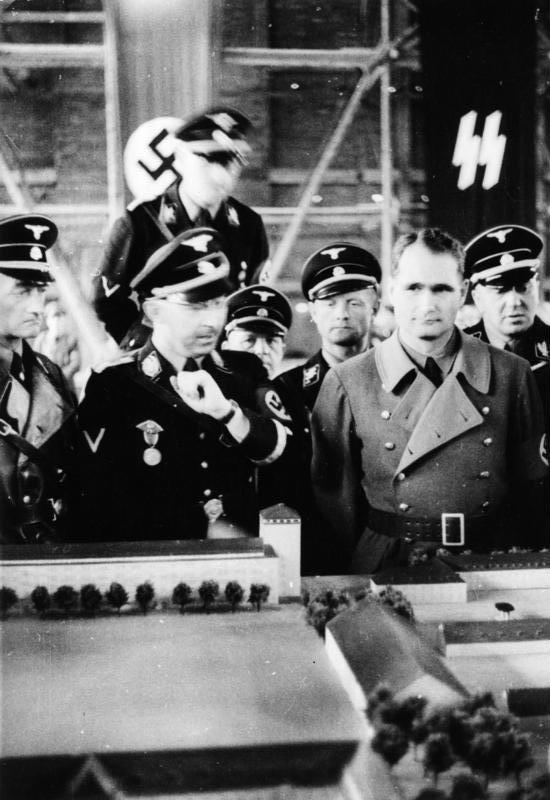 Himmler and Rudolf Hess in 1936, viewing a scale model of Dachau concentration camp Himmler's organised, bookish intellect served him well as he began setting up different SS departments. In 1931 he appointed Reinhard Heydrich chief of the new Ic Service (intelligence service), which was renamed the Sicherheitsdienst (SD: Security Service) in 1932. He later officially appointed Heydrich his deputy.[56] The two men had a good working relationship and a mutual respect.[57] In 1933, they began to remove the SS from SA control. Along with Interior Minister Frick, they hoped to create a unified German police force. In March 1933, Reich Governor of Bavaria Franz Ritter von Epp appointed Himmler chief of the Munich Police. Himmler appointed Heydrich commander of Department IV, the political police.[58] Thereafter, Himmler and Heydrich took over the political police of state after state; soon only Prussia was controlled by Göring.[59] Effective 1 January 1933, Hitler promoted Himmler to the rank of SS-Obergruppenführer, equal in rank to the senior SA commanders.[60] On 2 June Himmler, along with the heads of the other two Nazi paramilitary organizations, the SA and the Hitler Youth, was named a Reichsleiter, the second highest political rank in the Nazi Party. On 10 July, he was named to the Prussian State Council.[46] On 2 October 1933, he became a founding member of Hans Frank's Academy for German Law at its inaugural meeting.[61] Himmler further established the SS Race and Settlement Main Office (Rasse- und Siedlungshauptamt or RuSHA). He appointed Darré as its first chief, with the rank of SS-Gruppenführer. The department implemented racial policies and monitored the "racial integrity" of the SS membership.[62] SS men were carefully vetted for their racial background. On 31 December 1931, Himmler introduced the "marriage order", which required SS men wishing to marry to produce family trees proving that both families were of Aryan descent to 1800.[63] If any non-Aryan forebears were found in either family tree during the racial investigation, the person concerned was excluded from the SS.[64] Each man was issued a Sippenbuch, a genealogical record detailing his genetic history.[65] Himmler expected that each SS marriage should produce at least four children, thus creating a pool of genetically superior prospective SS members. The programme had disappointing results; less than 40 per cent of SS men married and each produced only about one child.[66] In March 1933, less than three months after the Nazis came to power, Himmler set up the first official concentration camp at Dachau.[67] Hitler had stated that he did not want it to be just another prison or detention camp. Himmler appointed Theodor Eicke, a convicted felon and ardent Nazi, to run the camp in June 1933.[68] Eicke devised a system that was used as a model for future camps throughout Germany.[38] Its features included isolation of victims from the outside world, elaborate roll calls and work details, the use of force and executions to exact obedience, and a strict disciplinary code for the guards. Uniforms were issued for prisoners and guards alike; the guards' uniforms had a special Totenkopf insignia on their collars. By the end of 1934, Himmler took control of the camps under the aegis of the SS, creating a separate division, the SS-Totenkopfverbände.[69][70] Initially the camps housed political opponents; over time, undesirable members of German society—criminals, vagrants, deviants—were placed in the camps as well. In 1936 Himmler wrote in the pamphlet "The SS as an Anti-Bolshevist Fighting Organization" that the SS were to fight against the "Jewish-Bolshevik revolution of subhumans".[71] A Hitler decree issued in December 1937 allowed for the incarceration of anyone deemed by the regime to be an undesirable member of society.[72] This included Jews, Gypsies, communists, and those persons of any other cultural, racial, political, or religious affiliation deemed by the Nazis to be Untermensch (sub-human). Thus, the camps became a mechanism for social and racial engineering. By the outbreak of World War II in autumn 1939, there were six camps housing some 27,000 inmates. Death tolls were high.[73] |
親衛隊での出世 1929年のヒムラー 1929年1月にSS司令官エルハルト・ハイデンが辞任すると、ヒムラーはヒトラーの承認を得てSS総統に就任した[37][40][a]。彼の最初の責 務のひとつは、同年9月のニュルンベルク集会における親衛隊の参加者を組織することであった[41]。1930年までにヒムラーはヒトラーを説得し、SS を独立した組織として運営するようにしたが、公式にはまだSAに従属するものであった[42][43]。 政治権力を獲得するために、ナチ党は世界大恐慌の経済不況を利用した。ヴァイマル共和国の連立政権は経済を改善することができなかったため、多くの有権者 はナチ党を含む極端な政治に傾倒した。1930年9月、ヒムラーは帝国議会代議員に初当選した。 [ヒトラーは1933年1月30日にパウル・フォン・ヒンデンブルク大統領によってドイツ首相に任命され、ナチスとドイツ国民党の短期間の連立政権を率い た。新内閣には当初、ナチ党員は3人だけだった: ヒトラー、無任所大臣兼プロイセン内相のヘルマン・ゲーリング、帝国内相のヴィルヘルム・フリックであった[48][49]。1ヵ月も経たないうちに、帝 国議会議事堂が放火された。ヒトラーはこの出来事を利用し、ヒンデンブルクに基本的権利を停止し、裁判なしの拘禁を認めた帝国議会火災令に署名させた [50]。1933年3月23日に帝国議会で可決された実行法は、内閣、実際にはヒトラーに完全な立法権を与え、国内は事実上の独裁国家となった [51]。1934年8月1日、ヒトラー内閣はヒンデンブルクの死後、大統領職を廃止し、その権限を首相職に統合することを定めた法律を可決した。翌朝、 ヒンデンブルクは死去し、ヒトラーは国家元首となり、総統兼首相の称号を得た[52]。 ナチ党の台頭は、ヒムラーと親衛隊に自由な繁栄の機会を与えた。1933年までに、SSは52,000人の隊員を数えた[53]。厳格な入隊条件によっ て、すべての隊員がヒトラーのアーリア人ヘレンヴォルク(「アーリア人の支配者民族」)であることが保証された。応募者は北欧人の資質を審査された。ヒム ラーの言葉を借りれば、「不純物が混入され堕落した古き良き系統を再現しようとする苗木屋のようなものである。  1936年、ダッハウ強制収容所の模型を見るヒムラーとルドルフ・ヘス。 ヒムラーの組織化された書物好きな知性は、彼がさまざまなSS部門を設立し始めたときに大いに役立った。1931年、彼はラインハルト・ハイドリヒを新し いIcサービス(情報部)のチーフに任命し、1932年にSD(保安部)と改名した。1933年、彼らは親衛隊をSAの支配から排除し始めた。内務大臣フ リックとともに、彼らは統一されたドイツ警察を創設することを望んだ。1933年3月、バイエルン州知事フランツ・リッター・フォン・エップはヒムラーを ミュンヘン警察署長に任命した。ヒムラーはハイドリヒを政治警察第4部の司令官に任命した[58]。その後、ヒムラーとハイドリヒは次々と州の政治警察を 引き継ぎ、やがてプロイセンだけがゲーリングの支配下に置かれるようになった[59]。1933年1月1日、ヒトラーはヒムラーを親衛隊親衛隊長に昇格さ せた。1933年10月2日、ハンス・フランクのドイツ法アカデミーの創立総会で創立メンバーとなった[61]。 ヒムラーはさらに親衛隊人種・入植本局(Rasse- und Siedlungshauptamt、RuSHA)を設立した。彼はダレをその初代長官に任命し、SS親衛隊長の地位に就けた。この部門は人種政策を実施 し、SS隊員の「人種的完全性」を監視した[62]。1931年12月31日、ヒムラーは「結婚命令」を導入し、結婚を希望するSS隊員に対して、両家が 1800年までのアーリア系であることを証明する家系図の提出を求めた[63]。この計画は期待外れの結果となり、結婚したSS隊員は40パーセントに満 たず、それぞれ1人程度の子供しか生まなかった[66]。 1933年3月、ナチスが政権を握ってから3ヶ月も経たないうちに、ヒムラーは最初の公式強制収容所をダッハウに設置した[67]。ヒムラーは、1933 年6月に、有罪判決を受けた重罪犯で熱烈なナチス党員であったテオドール・アイケを収容所の運営に任命した[68]。アイケは、将来のドイツ全土の収容所 のモデルとなるシステムを考案した[38]。その特徴には、犠牲者の外部からの隔離、精巧な点呼と作業内容、服従を強制するための武力行使と処刑、看守の 厳格な規律規定などがあった。囚人にも看守にも制服が支給され、看守の制服の襟には、トーテンコップの特別な記章が付けられていた。1934年末までに、 ヒムラーは親衛隊の庇護のもとに収容所を管理し、独立した部門である親衛隊トーテンコップフベルベンデを創設した[69][70]。 当初、収容所には政治的敵対者が収容されていたが、やがて、犯罪者、浮浪者、逸脱者といったドイツ社会の好ましくない構成員も収容されるようになった。 1936年、ヒムラーは小冊子『反ボリシェヴィズム戦闘組織としてのSS』に、SSは「亜人のユダヤ人・ボリシェヴィキ革命」と戦うものであると書いてい る[71]。1937年12月に出されたヒトラーの法令では、政権が社会的に好ましくない構成員であるとみなした人物を収容することを認めていた [72]。 これには、ユダヤ人、ジプシー、共産主義者、その他ナチスがウンターメンシュ(亜人)であるとみなした文化的、人種的、政治的、宗教的なあらゆる人々が含 まれていた[72]。こうして収容所は、社会的・人種的工学の仕組みとなった。1939年秋に第二次世界大戦が勃発するまでに、6つの収容所に約 27,000人が収容された。死者数は多かった[73]。 |
| Consolidation of power In early 1934, Hitler and other Nazi leaders became concerned that Röhm was planning a coup d'état.[74] Röhm had socialist and populist views and believed that the real revolution had not yet begun. He felt that the SA—now numbering some three million men, far dwarfing the army—should become the sole arms-bearing corps of the state, and that the army should be absorbed into the SA under his leadership. Röhm lobbied Hitler to appoint him Minister of Defence, a position held by conservative General Werner von Blomberg.[75] Göring had created a Prussian secret police force, the Geheime Staatspolizei or Gestapo in 1933 and appointed Rudolf Diels as its head. Göring, concerned that Diels was not ruthless enough to use the Gestapo effectively to counteract the power of the SA, handed over its control to Himmler on 20 April 1934.[76] Also on that date, Hitler appointed Himmler chief of all German police outside Prussia. This was a radical departure from long-standing German practice that law enforcement was a state and local matter. Heydrich, named chief of the Gestapo by Himmler on 22 April 1934, also continued as head of the SD.[77] Hitler decided on 21 June that Röhm and the SA leadership had to be eliminated. He sent Göring to Berlin on 29 June, to meet with Himmler and Heydrich to plan the action. Hitler took charge in Munich, where Röhm was arrested; he gave Röhm the choice to commit suicide or be shot. When Röhm refused to kill himself, he was shot dead by two SS officers. Between 85 and 200 members of the SA leadership and other political adversaries, including Gregor Strasser, were killed between 30 June and 2 July 1934 in these actions, known as the Night of the Long Knives.[78][79] With the SA thus neutralised, the SS became an independent organisation answerable only to Hitler on 20 July 1934. Himmler's title of Reichsführer-SS became the highest formal SS rank, equivalent to a field marshal in the army.[80] The SA was converted into a sports and training organisation.[81] On 15 September 1935, Hitler presented two laws—known as the Nuremberg Laws—to the Reichstag. The laws banned marriage between non-Jewish and Jewish Germans and forbade the employment of non-Jewish women under the age of 45 in Jewish households. The laws also deprived so-called "non-Aryans" of the benefits of German citizenship.[82] These laws were among the first race-based measures instituted by the Third Reich. Himmler and Heydrich wanted to extend the power of the SS; thus, they urged Hitler to form a national police force overseen by the SS, to guard Nazi Germany against its many enemies at the time—real and imagined.[83] Interior Minister Frick also wanted a national police force, but one controlled by him, with Kurt Daluege as his police chief.[84] Hitler left it to Himmler and Heydrich to work out the arrangements with Frick. Himmler and Heydrich had greater bargaining power, as they were allied with Frick's old enemy, Göring. Heydrich drew up a set of proposals and Himmler sent him to meet with Frick. An angry Frick then consulted with Hitler, who told him to agree to the proposals. Frick acquiesced, and on 17 June 1936 Hitler decreed the unification of all police forces in the Reich and named Himmler Chief of German Police and a State Secretary in the Ministry of the Interior.[84] In this role, Himmler was still nominally subordinate to Frick. In practice, however, the police were now effectively a division of the SS, and hence independent of Frick's control. This move gave Himmler operational control over Germany's entire detective force.[84][85] He also gained authority over all of Germany's uniformed law enforcement agencies, which were amalgamated into the new Ordnungspolizei (Orpo: "order police"), which became a branch of the SS under Daluege.[84] 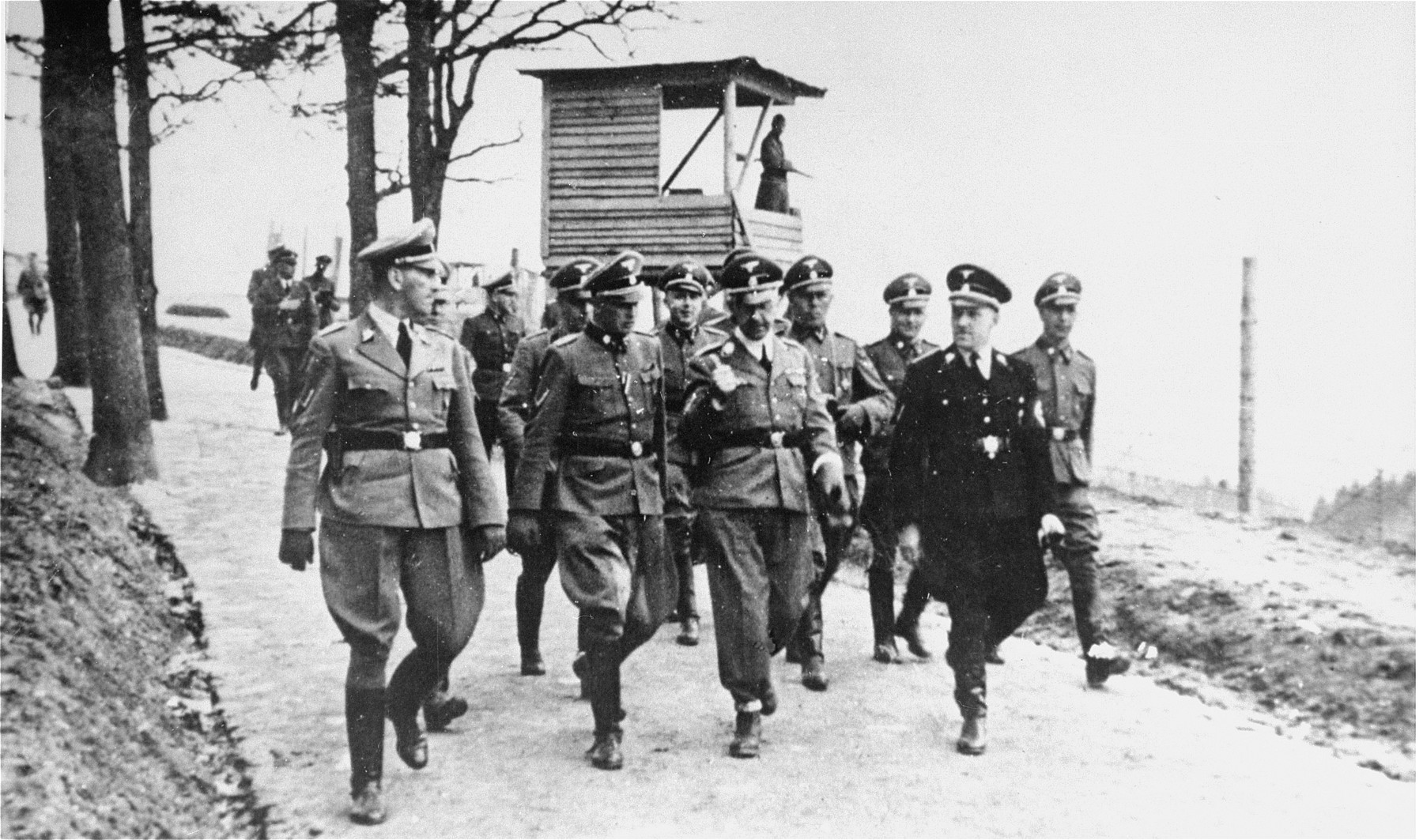 Himmler, Ernst Kaltenbrunner, and other SS officials visiting Mauthausen concentration camp in 1941 Shortly thereafter, Himmler created the Kriminalpolizei (Kripo: criminal police) as an umbrella organisation for all criminal investigation agencies in Germany. The Kripo was merged with the Gestapo into the Sicherheitspolizei (SiPo: security police), under Heydrich's command.[86] In September 1939, following the outbreak of World War II, Himmler formed the SS-Reichssicherheitshauptamt (RSHA: Reich Security Main Office) to bring the SiPo (which included the Gestapo and Kripo) and the SD together under one umbrella. He again placed Heydrich in command.[87] Under Himmler's leadership, the SS developed its own military branch, the SS-Verfügungstruppe (SS-VT), which later evolved into the Waffen-SS. Nominally under the authority of Himmler, the Waffen-SS developed a fully militarised structure of command and operations. It grew from three regiments to over 38 divisions during World War II, serving alongside the Heer (army), but never being formally part of it.[88] In addition to his military ambitions, Himmler established the beginnings of a parallel economy under the umbrella of the SS.[89] To this end, administrator Oswald Pohl set up the Deutsche Wirtschaftsbetriebe (German Economic Enterprise) in 1940. Under the auspices of the SS Economy and Administration Head Office, this holding company owned housing corporations, factories, and publishing houses.[90] Pohl was unscrupulous and quickly exploited the companies for personal gain. In contrast, Himmler was honest in matters of money and business.[91] In 1938, as part of his preparations for war, Hitler ended the German alliance with China and entered into an agreement with the more modern Japan. That same year, Austria was unified with Nazi Germany in the Anschluss, and the Munich Agreement gave Nazi Germany control over the Sudetenland, part of Czechoslovakia.[92] Hitler's primary motivations for war included obtaining additional Lebensraum ("living space") for the Germanic peoples, who were considered racially superior according to Nazi ideology.[93] A second goal was the elimination of those considered racially inferior, particularly the Jews and Slavs, from territories controlled by the Reich. From 1933 to 1938, hundreds of thousands of Jews emigrated to the United States, Palestine, Great Britain, and other countries. Some converted to Christianity.[94] Anti-church struggle Main articles: Kirchenkampf and Nazi persecution of the Catholic Church According to Himmler biographer Peter Longerich, Himmler believed that a major task of the SS should be "acting as the vanguard in overcoming Christianity and restoring a 'Germanic' way of living" as part of preparations for the coming conflict between "humans and subhumans".[95] Longerich wrote that, while the Nazi movement as a whole launched itself against Jews and Communists, "by linking de-Christianisation with re-Germanization, Himmler had provided the SS with a goal and purpose all of its own".[95] Himmler was vehemently opposed to Christian sexual morality and the "principle of Christian mercy", both of which he saw as dangerous obstacles to his planned battle with "subhumans".[95] In 1937, Himmler declared: We live in an era of the ultimate conflict with Christianity. It is part of the mission of the SS to give the German people in the next half century the non-Christian ideological foundations on which to lead and shape their lives. This task does not consist solely in overcoming an ideological opponent but must be accompanied at every step by a positive impetus: in this case that means the reconstruction of the German heritage in the widest and most comprehensive sense.[96] In early 1937, Himmler had his personal staff work with academics to create a framework to replace Christianity within the Germanic cultural heritage. The project gave rise to the Deutschrechtliches Institut, headed by Professor Karl Eckhardt, at the University of Bonn.[97] |
権力の強化 1934年初頭、ヒトラーをはじめとするナチスの指導者たちは、レームがクーデターを計画しているのではないかと懸念するようになった[74]。レームは 社会主義的・大衆主義的な考えを持っており、真の革命はまだ始まっていないと考えていた。レームは、現在300万人ほどの兵員を擁し、陸軍をはるかに凌ぐ SAが国家の唯一の武器保有部隊となるべきであり、陸軍はレームの指導の下でSAに吸収されるべきだと考えていた。レームはヒトラーに働きかけ、保守派の ヴェルナー・フォン・ブロムベルク将軍が務めていた国防大臣に任命させた[75]。 ゲーリングは1933年にプロイセンの秘密警察ゲシュタポを創設し、ルドルフ・ディールスをそのトップに任命した。ゲシュタポを効果的に使ってSAの権力 に対抗するにはディールスが冷酷さに欠けることを懸念したゲーリングは、1934年4月20日にゲシュタポの管理をヒムラーに引き継いだ[76]。これ は、法の執行は州と地方の問題であるというドイツの長年の慣行からの根本的な逸脱であった。1934年4月22日にヒムラーによってゲシュタポの長官に任 命されたハイドリヒは、SDの長官も続けた[77]。 ヒトラーは6月21日、レームとSA指導部の排除を決定した。ヒトラーは6月29日にゲーリングをベルリンに送り、ヒムラーとハイドリヒと会談して作戦を 立案させた。ヒトラーはレームが逮捕されたミュンヘンで指揮を執り、レームに自殺か銃殺かの選択を迫った。レームが自殺を拒否すると、彼は2人のSS将校 に射殺された。1934年6月30日から7月2日の間に、グレゴール・シュトラッサーを含む85人から200人のSA指導部メンバーやその他の政敵が、 「長いナイフの夜」として知られるこれらの行動で殺害された[78][79]。こうしてSAが無力化されたことで、SSは1934年7月20日にヒトラー にのみ答える独立組織となった。ヒムラーのライヒスフューラーSSの称号は、陸軍の野戦元帥に相当するSSの最高位となった[80]。 1935年9月15日、ヒトラーはニュルンベルク法として知られる2つの法律を帝国議会に提出した。この法律は非ユダヤ人とユダヤ系ドイツ人との結婚を禁 止し、ユダヤ人家庭で45歳未満の非ユダヤ人女性を雇用することを禁じた。この法律はまた、いわゆる「非アーリア人」からドイツ市民権の利益を剥奪した [82]。これらの法律は第三帝国によって制定された最初の人種に基づく措置のひとつであった。 ヒムラーとハイドリヒは親衛隊の権力を拡大することを望んでいた。そのため、彼らはナチス・ドイツを当時の現実と想像の多くの敵から守るために、親衛隊が 監督する国家警察を結成するようヒトラーに促した[83]。フリック内務大臣も国家警察を望んでいたが、クルト・ダリューゲを警察署長とし、彼が管理する ものであった[84]。ヒムラーとハイドリヒはフリックの宿敵ゲーリングと同盟を結んでいたため、より大きな交渉力を持っていた。ハイドリヒは一連の提案 を作成し、ヒムラーは彼をフリックとの会談に送り込んだ。怒ったフリックはヒトラーに相談し、ヒトラーは提案に同意するように言った。フリックはこれを承 諾し、1936年6月17日、ヒトラーは帝国内の全警察の統一を布告し、ヒムラーをドイツ警察長官兼内務省事務次官に任命した[84]。しかし実際には、 警察は事実上SSの一部門であり、したがってフリックの支配から独立していた。この動きによって、ヒムラーはドイツの全刑事部隊の作戦統制権を獲得した [84][85]。 また、彼はドイツのすべての制服法執行機関の権限を獲得し、それらはダリューゲのもとでSSの一部門となった新しいOrdnungspolizei (Orpo:「秩序警察」)に統合された[84]。  1941年、マウトハウゼン強制収容所を訪れたヒムラー、エルンスト・カルテンブルンナーらSS幹部 その後まもなく、ヒムラーはドイツ国内のすべての犯罪捜査機関の統括組織としてクリミナルポリツァイ(クリポ:刑事警察)を創設した。第二次世界大戦勃発 後の1939年9月、ヒムラーは、ゲシュタポとクリポを含むクリミナルポリツァイとSDを一つの傘下に置くために、SS- Reichssicherheitshauptamt(RSHA:帝国保安本局)を設立した。彼はハイドリヒを再び指揮官に据えた[87]。 ヒムラーの指導の下、SSは独自の軍事部門であるSS-Verfügungstruppe(SS-VT)を発展させ、それは後にヴァッフェンSSへと発展 した。ヴァッフェンSSは名目上ヒムラーの指揮下に置かれ、指揮と作戦の完全な軍国主義的構造を発展させた。第二次世界大戦中、3個連隊から38個師団を 超えるまでに成長し、ヘール(陸軍)と並行して活動したが、正式に陸軍の一部となることはなかった[88]。 軍事的野心に加えて、ヒムラーは親衛隊の傘下で並行経済の始まりを築いた[89]。この目的のために、管理官オズワルト・ポールは1940年にドイツ経済 企業を設立した。SS経済管理本部の後援のもと、この持ち株会社は住宅会社、工場、出版社を所有していた[90]。これとは対照的に、ヒムラーは金銭とビ ジネスに関しては正直であった[91]。 1938年、ヒトラーは戦争準備の一環として、ドイツと中国との同盟を解消し、より近代的な日本と協定を結んだ。同じ年、オーストリアはナチス・ドイツと 統合され、ミュンヘン協定によってナチス・ドイツはチェコスロバキアの一部であるスデーテンラントを支配することになった[92]。ヒトラーの戦争への主 な動機は、ナチスのイデオロギーによれば人種的に優れていると考えられていたゲルマン民族のための新たなレーベンスラウム(「生活空間」)の獲得であった [93]。1933年から1938年にかけて、何十万人ものユダヤ人がアメリカ、パレスチナ、イギリスなどに移住した。キリスト教に改宗する者もいた [94]。 反教会闘争 主な記事 キルヒェンカンプフとナチスのカトリック教会迫害 ヒムラーの伝記作者ペーター・ロンゲリヒによれば、ヒムラーはSSの主要な任務は、来るべき「人間と亜人」の対立への準備の一環として、「キリスト教を克 服し、『ゲルマン的』生活様式を回復する前衛として行動すること」であると信じていた。 [ヒムラーは、キリスト教的性道徳と「キリスト教的慈悲の原則」に猛烈に反対していたが、これらはいずれも、彼が計画した「亜人」との戦いにとって危険な 障害であるとみなしていた[95]: 我々はキリスト教と究極的に対立する時代に生きている。これからの半世紀のドイツ国民に、キリスト教以外のイデオロギー的基盤を与え、それに基づいて彼ら の生活を導き、形成することは、SSの使命の一部である。この任務は、単にイデオロギー上の敵対勢力を克服することだけで成り立つものではなく、あらゆる 段階において積極的な推進力を伴わなければならない。 1937年初頭、ヒムラーは、ゲルマン文化遺産の中でキリスト教に取って代わる枠組みを作るために、彼の個人的なスタッフに学者たちと協力させた。このプ ロジェクトは、ボン大学のカール・エクハルト教授が率いるドイツ文化研究所を生み出した[97]。 |
| World War II When Hitler and his army chiefs asked for a pretext for the invasion of Poland in 1939, Himmler, Heydrich, and Heinrich Müller masterminded and carried out a false flag project code-named Operation Himmler. German soldiers dressed in Polish uniforms undertook border skirmishes which deceptively suggested Polish aggression against Germany. The incidents were then used in Nazi propaganda to justify the invasion of Poland, the opening event of World War II.[98] At the beginning of the war against Poland, Hitler authorised the killing of Polish civilians, including Jews and ethnic Poles. The Einsatzgruppen (SS task forces) had originally been formed by Heydrich to secure government papers and offices in areas taken over by Germany before World War II.[99] Authorised by Hitler and under the direction of Himmler and Heydrich, the Einsatzgruppen units—now repurposed as death squads—followed the Heer (army) into Poland, and by the end of 1939 they had murdered some 65,000 intellectuals and other civilians. Militias and Heer units also took part in these killings.[100][101] Under Himmler's orders via the RSHA, these squads were also tasked with rounding up Jews and others for placement in ghettos and concentration camps.  Himmler with Indian nationalist Subhas Chandra Bose in 1942 Germany subsequently invaded Denmark and Norway, the Netherlands, and France, and began bombing Great Britain in preparation for Operation Sea Lion, the planned invasion of the United Kingdom.[102] On 21 June 1941, the day before invasion of the Soviet Union, Himmler commissioned the preparation of the Generalplan Ost (General Plan for the East); the plan was approved by Hitler in May 1942. It called for the Baltic States, Poland, Western Ukraine, and Byelorussia to be conquered and resettled by ten million German citizens. The current residents—some 31 million people—would be expelled further east, starved, or used for forced labour. The plan would have extended the borders of Germany to the east by one thousand kilometres (600 miles). Himmler expected that it would take twenty to thirty years to complete the plan, at a cost of 67 billion ℛ︁ℳ︁.[103] Himmler stated openly: "It is a question of existence, thus it will be a racial struggle of pitiless severity, in the course of which 20 to 30 million Slavs and Jews will perish through military actions and crises of food supply."[104] Himmler declared that the war in the east was a pan-European crusade to defend the traditional values of old Europe from the "Godless Bolshevik hordes".[105] Constantly struggling with the Wehrmacht for recruits, Himmler solved this problem through the creation of Waffen-SS units composed of Germanic folk groups taken from the Balkans and eastern Europe. Equally vital were recruits from among the Germanic considered peoples of northern and western Europe, in the Netherlands, Norway, Belgium, Denmark and Finland.[106] Spain and Italy also provided men for Waffen-SS units.[107] Among western countries, the number of volunteers varied from a high of 25,000 from the Netherlands[108] to 300 each from Sweden and Switzerland. From the east, the highest number of men came from Lithuania (50,000) and the lowest from Bulgaria (600).[109] After 1943 most men from the east were conscripts. The performance of the eastern Waffen-SS units was, as a whole, sub-standard.[110] In late 1941, Hitler named Heydrich as Deputy Reich Protector of the newly established Protectorate of Bohemia and Moravia. Heydrich began to racially classify the Czechs, deporting many to concentration camps. Members of a swelling resistance were shot, earning Heydrich the nickname "the Butcher of Prague".[111] This appointment strengthened the collaboration between Himmler and Heydrich, and Himmler was proud to have SS control over a state. Despite having direct access to Hitler, Heydrich's loyalty to Himmler remained firm.[112] With Hitler's approval, Himmler re-established the Einsatzgruppen in the lead-up to the planned invasion of the Soviet Union. In March 1941, Hitler addressed his army leaders, detailing his intention to smash the Soviet Empire and destroy the Bolshevik intelligentsia and leadership.[113] His special directive, the "Guidelines in Special Spheres re Directive No. 21 (Operation Barbarossa)", read: "In the operations area of the army, the Reichsführer-SS has been given special tasks on the orders of the Führer, in order to prepare the political administration. These tasks arise from the forthcoming final struggle of two opposing political systems. Within the framework of these tasks, the Reichsführer-SS acts independently and on his own responsibility."[114] Hitler thus intended to prevent internal friction like that occurring earlier in Poland in 1939, when several German Army generals (including Johannes Blaskowitz) had attempted to bring Einsatzgruppen leaders to trial for the murders they had committed.[114] 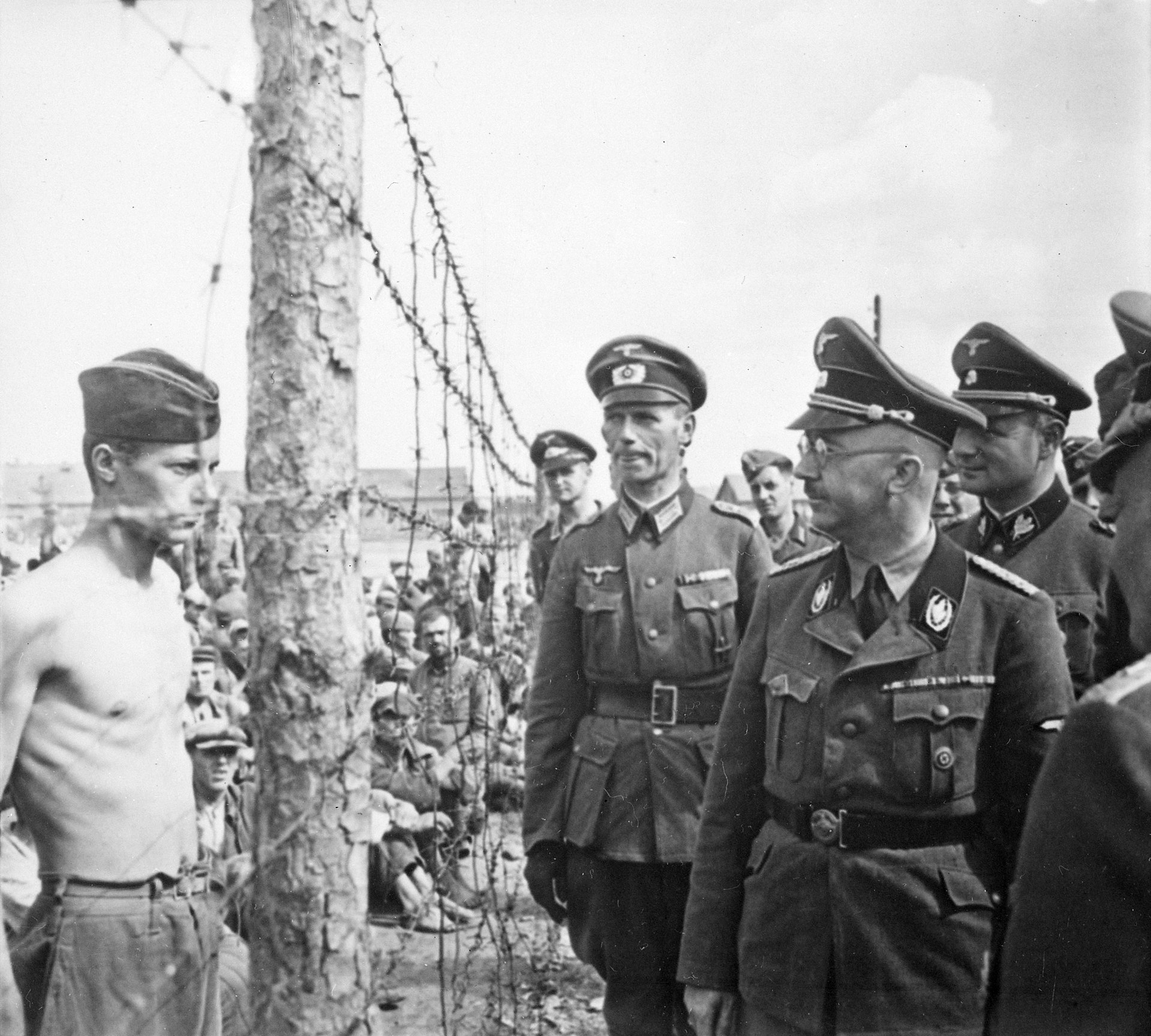 Himmler inspects a prisoner of war camp in Russia, c. 1941 Following the army into the Soviet Union, the Einsatzgruppen rounded up and killed Jews and others deemed undesirable by the Nazi state.[115] Hitler was sent frequent reports.[116] In addition, 2.8 million Soviet prisoners of war died of starvation, mistreatment or executions in just eight months of 1941–42.[117] As many as 500,000 Soviet prisoners of war died or were executed in Nazi concentration camps over the course of the war; most of them were shot or gassed.[118] By early 1941, following Himmler's orders, ten concentration camps had been constructed in which inmates were subjected to forced labour.[119] Jews from all over Germany and the occupied territories were deported to the camps or confined to ghettos. As the Germans were pushed back from Moscow in December 1941, signalling that the expected quick defeat of the Soviet Union had failed to materialize, Hitler and other Nazi officials realised that mass deportations to the east would no longer be possible. As a result, instead of deportation, many Jews in Europe were destined for death.[120][121] |
第二次世界大戦 1939年、ヒトラーとその陸軍参謀たちがポーランド侵攻の口実を求めたとき、ヒムラー、ハイドリヒ、ハインリヒ・ミュラーは、ヒムラー作戦というコード ネームの偽旗計画を立案し、実行に移した。ポーランドの軍服に身を包んだドイツ兵が国境で小競り合いを行い、ポーランドのドイツ侵攻を欺いたのである。こ の事件は、第二次世界大戦の開戦イベントであるポーランド侵攻を正当化するために、ナチスのプロパガンダに利用された[98]。ポーランドとの戦争が始ま ると、ヒトラーはユダヤ人やポーランド人を含むポーランド民間人の殺害を許可した。アインザッツグルッペン(親衛隊機動部隊)はもともと、第二次世界大戦 前にドイツが占領した地域の政府書類や事務所を確保するためにハイドリッヒによって編成されたものであった[99]。ヒトラーによって認可され、ヒムラー とハイドリッヒの指揮の下、アインザッツグルッペン部隊(現在は死の部隊として再利用されている)は、ヘール(軍隊)に続いてポーランドに入り、1939 年末までに約65,000人の知識人やその他の民間人を殺害した。民兵やヘール部隊もこれらの殺害に参加した[100][101]。RSHAを通じたヒム ラーの命令の下、これらの部隊はゲットーや強制収容所に収容するためにユダヤ人などを一網打尽にする任務も負っていた。  1942年、インドの民族主義者スバス・チャンドラ・ボースとヒムラー。 ドイツはその後、デンマーク、ノルウェー、オランダ、フランスに侵攻し、イギリス侵攻計画であるシーライオン作戦の準備としてイギリス爆撃を開始した [102]。ソ連侵攻の前日である1941年6月21日、ヒムラーは「東方総合計画」(Generalplan Ost)の作成を命じた。計画は1942年5月にヒトラーによって承認され、バルト三国、ポーランド、西ウクライナ、ベラルーシを征服し、1000万人の ドイツ国民を再定住させるというものだった。現在の住民(約3100万人)は、さらに東に追放されるか、飢餓状態に置かれるか、強制労働に使われることに なる。この計画によって、ドイツの国境は東に1,000キロ(600マイル)延長されることになる。ヒムラーは、670億㌆㌆の費用をかけて、この計画を 完成させるのに20年から30年かかると予想していた[103]: 「それは存亡の問題であり、したがってそれは無慈悲で過酷な人種闘争となり、その過程で2000万から3000万のスラヴ人とユダヤ人が軍事行動と食糧供 給の危機によって滅びるだろう」[104]。 ヒムラーは、東方での戦争は、「神なきボルシェビキの大軍」から古いヨーロッパの伝統的価値を守るための汎ヨーロッパ十字軍であると宣言した[105]。 新兵のために常にドイツ国防軍と苦闘していたヒムラーは、バルカン半島と東ヨーロッパから集められたゲルマン民族から構成されるヴァッフェンSS部隊の創 設によってこの問題を解決した。スペインとイタリアもヴァッフェン=SS部隊に人員を提供した[107]。西側諸国では、志願兵の数は最高でオランダの 25,000人から[108]、スウェーデンとスイスの各300人まで様々であった。東部では、リトアニア(50,000人)が最も多く、ブルガリア (600人)が最も少なかった[109]。東部ヴァッフェンSS部隊のパフォーマティビティは全体として水準以下であった[110]。 1941年末、ヒトラーはハイドリヒを新しく設立されたボヘミア・モラヴィア保護領のライヒ副保護官に指名した。ハイドリヒはチェコ人を人種的に分類し始 め、その多くを強制収容所に追放した。膨れ上がったレジスタンスのメンバーは射殺され、ハイドリヒは「プラハの虐殺者」というニックネームを得た [111]。この任命によってヒムラーとハイドリヒの協力関係は強化され、ヒムラーは親衛隊が国家を支配していることを誇りに思った。ヒトラーに直接接触 できるにもかかわらず、ハイドリヒのヒムラーへの忠誠心は揺るぎなかった[112]。 ヒトラーの承認を得て、ヒムラーはソ連侵攻計画に向けてアインザッツグルッペンを再興した。1941年3月、ヒトラーは陸軍指導者たちに演説し、ソビエト 帝国を粉砕し、ボリシェヴィキの知識階級と指導部を壊滅させるという彼の意図を詳述した[113]。彼の特別指令である「指令第21号(バルバロッサ作 戦)に関する特別領域におけるガイドライン」にはこうあった: 「陸軍の作戦地域では、総統の命令により、政治行政を準備するために、帝国総統親衛隊に特別な任務が与えられている。これらの任務は、対立する2つの政治 体制の最終的な闘争が間近に迫っていることから生じている。これらの任務の枠内で、帝国総統SSは独立して、自らの責任において行動する」[114]。ヒ トラーはこのようにして、1939年にポーランドで起こったような内部摩擦を防ぐことを意図していた。このとき、(ヨハネス・ブラスコヴィッツを含む)数 名のドイツ陸軍将兵は、アインザッツグルッペンの指導者たちを、彼らが犯した殺人事件の裁判にかけようとした[114]。  ロシアの捕虜収容所を視察するヒムラー(1941年頃 アインザッツグルッペンは軍隊のソビエト連邦進駐に続いて、ユダヤ人やナチス国家が望ましくないとみなした人々を一網打尽にして殺害した。 [1941年初頭までに、ヒムラーの命令に従って10の強制収容所が建設され、収容者は強制労働に従事させられた[119]。1941年12月にドイツ軍 がモスクワから押し戻され、ソビエト連邦の速やかな敗北が期待されたが実現しなかったことを示すと、ヒトラーをはじめとするナチス高官たちは、東方への大 量強制送還はもはや不可能であることを悟った。その結果、ヨーロッパでは国外追放の代わりに多くのユダヤ人が死を運命づけられた[120][121]。 |
| Final Solution, the Holocaust,
racial policy, and eugenics Further information: Final Solution, the Holocaust, Nazism and race, Racial policy of Nazi Germany, and Nazi eugenics 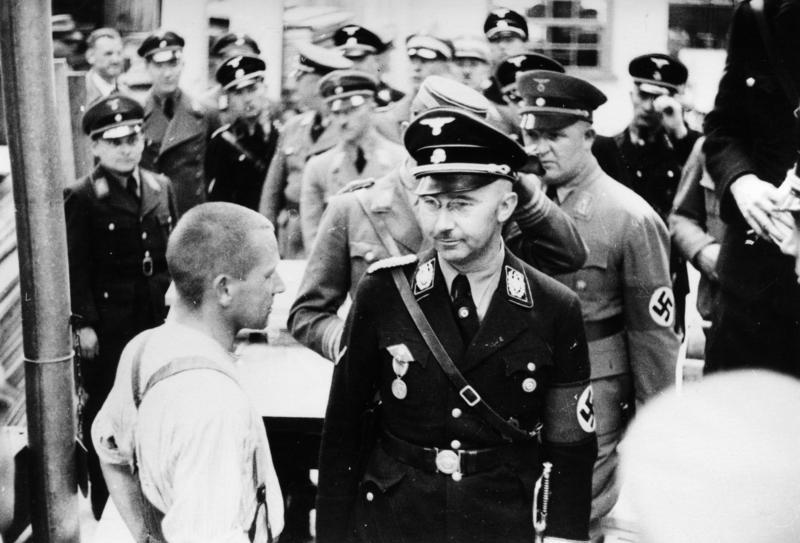 Himmler visiting the Dachau concentration camp in 1936 |
最終解決、ホロコースト、人種政策、優生学 さらなる情報 最終解決、ホロコースト、ナチズムと人種、ナチスドイツの人種政策、ナチスの優生学  1936年、ダッハウ強制収容所を訪れたヒムラー |
| Nazi racial policies, including
the notion that people who were racially inferior had no right to live,
date back to the earliest days of the party; Hitler discusses this in
Mein Kampf.[122] Around the time of the German declaration of war on
the United States in December 1941, Hitler resolved that the Jews of
Europe were to be "exterminated".[121] Heydrich arranged a meeting,
held on 20 January 1942 at Wannsee, a suburb of Berlin. Attended by top
Nazi officials, it was used to outline the plans for the "final
solution to the Jewish question". Heydrich detailed how those Jews able
to work would be worked to death; those unable to work would be killed
outright. Heydrich calculated the number of Jews to be killed at 11
million and told the attendees that Hitler had placed Himmler in charge
of the plan.[123] In June 1942, Heydrich was assassinated in Prague in Operation Anthropoid, led by Jozef Gabčík and Jan Kubiš, members of Czechoslovakia's army-in-exile. Both men had been trained by the British Special Operations Executive for the mission to kill Heydrich.[124] During the two funeral services, Himmler—the chief mourner—took charge of Heydrich's two young sons, and he gave the eulogy in Berlin.[125] On 9 June, after discussions with Himmler and Karl Hermann Frank, Hitler ordered brutal reprisals for Heydrich's death.[124] Over 13,000 people were arrested, and the village of Lidice was razed to the ground; its male inhabitants and all adults in the village of Ležáky were murdered. At least 1,300 people were executed by firing squads.[126][127] Himmler took over leadership of the RSHA and stepped up the pace of the killing of Jews in Aktion Reinhard (Operation Reinhard), named in Heydrich's honour.[128] He ordered the Aktion Reinhard camps—three extermination camps—to be constructed at Bełżec, Sobibór, and Treblinka.[129] Initially the victims were killed with gas vans or by firing squad, but these methods proved impracticable for an operation of this scale.[130] In August 1941, Himmler attended the shooting of 100 Jews at Minsk. A "military virgin" this was the first time he heard a shot fired in anger or seen dead people, and in Minsk while looking into the open grave his coat and perhaps his face were splashed by the brains of a victim. He went very green and pale and swayed. Karl Wolff jumped forward, held him steady and led him away from the grave.[131] Nauseated and shaken by the experience,[132] he was concerned about the impact such actions would have on the mental health of his SS men. He decided that alternate methods of killing should be found.[133][134] On his orders, by early 1942 the camp at Auschwitz had been greatly expanded, including the addition of gas chambers, where victims were killed using the pesticide Zyklon B.[135] Himmler visited the camp in person on 17 and 18 July 1942. He was given a demonstration of a mass killing using the gas chamber in Bunker 2 and toured the building site of the new IG Farben plant being constructed at the nearby town of Monowitz.[136] By the end of the war, at least 5.5 million Jews had been killed by the Nazi regime;[137] most estimates range closer to 6 million.[138][139] Himmler visited the camp at Sobibór in early 1943, by which time 250,000 people had been killed at that location alone. After witnessing a gassing, he gave 28 people promotions and ordered the operation of the camp to be wound down. In a prisoner revolt that October, the remaining prisoners killed most of the guards and SS personnel. Several hundred prisoners escaped; about a hundred were immediately re-captured and killed. Some of the escapees joined partisan units operating in the area. The camp was dismantled by December 1943.[140] The Nazis also targeted Romani (Gypsies) as "asocial" and "criminals".[141] By 1935, they were confined into special camps away from ethnic Germans.[141] In 1938, Himmler issued an order in which he said that the "Gypsy question" would be determined by "race".[142] Himmler believed that the Romani were originally Aryan but had become a mixed race; only the "racially pure" were to be allowed to live.[143] In 1939, Himmler ordered thousands of Gypsies to be sent to the Dachau concentration camp and by 1942, ordered all Romani sent to Auschwitz concentration camp.[144] Himmler was one of the main architects of the Holocaust,[145][146][147] using his deep belief in the racist Nazi ideology to justify the murder of millions of victims. Longerich surmises that Hitler, Himmler, and Heydrich designed the Holocaust during a period of intensive meetings and exchanges in April–May 1942.[148] The Nazis planned to kill Polish intellectuals and restrict non-Germans in the General Government and conquered territories to a fourth-grade education.[149] They further wanted to breed a master race of racially pure Nordic Aryans in Germany. As a student of agriculture and a farmer, Himmler was acquainted with the principles of selective breeding, which he proposed to apply to humans. He believed that he could engineer the German populace, for example, through eugenics, to be Nordic in appearance within several decades of the end of the war.[150] Posen speeches Main article: Posen speeches On 4 October 1943, during a secret meeting with top SS officials in the city of Poznań (Posen), and on 6 October 1943, in a speech to the party elite—the Gauleiters and Reichsleiters—Himmler referred explicitly to the "extermination" (German: Ausrottung) of the Jewish people.[151] A translated excerpt from the speech of 4 October reads:[152] I also want to refer here very frankly to a very difficult matter. We can now very openly talk about this among ourselves, and yet we will never discuss this publicly. Just as we did not hesitate on 30 June 1934, to perform our duty as ordered and put comrades who had failed up against the wall and execute them, we also never spoke about it, nor will we ever speak about it. Let us thank God that we had within us enough self-evident fortitude never to discuss it among us, and we never talked about it. Every one of us was horrified, and yet every one clearly understood that we would do it next time, when the order is given and when it becomes necessary. I am talking about the "Jewish evacuation": the extermination of the Jewish people. It is one of those things that is easily said. "The Jewish people is being exterminated", every Party member will tell you, "perfectly clear, it's part of our plans, we're eliminating the Jews, exterminating them, ha!, a small matter." And then they turn up, the upstanding 80 million Germans, and each one has his decent Jew. They say the others are all swines, but this particular one is a splendid Jew. But none has observed it, endured it. Most of you here know what it means when 100 corpses lie next to each other, when there are 500 or when there are 1,000. To have endured this and at the same time to have remained a decent person—with exceptions due to human weaknesses—has made us tough, and is a glorious chapter that has not and will not be spoken of. Because we know how difficult it would be for us if we still had Jews as secret saboteurs, agitators and rabble-rousers in every city, what with the bombings, with the burden and with the hardships of the war. If the Jews were still part of the German nation, we would most likely arrive now at the state we were at in 1916 and '17 ...[153][154] Because the Allies had indicated that they were going to pursue criminal charges for German war crimes, Hitler tried to gain the loyalty and silence of his subordinates by making them all parties to the ongoing genocide. Hitler therefore authorised Himmler's speeches to ensure that all party leaders were complicit in the crimes and could not later deny knowledge of the killings.[151] Germanization policies and Generalplan Ost Main articles: Germanization and Generalplan Ost  Rudolf Hess, Himmler, Philipp Bouhler, Fritz Todt, Reinhard Heydrich, and others listening to Konrad Meyer at a Generalplan Ost exhibition, 20 March 1941 As Reich Commissioner for the Consolidation of German Nationhood (RKFDV) with the incorporated VoMi, Himmler was deeply involved in the Germanization program for the East, particularly Poland. As laid out in Generalplan Ost, the aim was to enslave, expel or exterminate the native population and to make Lebensraum ("living space") for Volksdeutsche (ethnic Germans). He continued his plans to colonise the east, even when many Germans were reluctant to relocate there, and despite negative effects on the war effort.[155][156] Approximately 11 million Slavic and 3.4 million Jewish inhabitants of Eastern Europe were killed in Nazi Germany's extermination campaigns during the implementation of Generalplan Ost.[157][158] Himmler's racial groupings began with the Volksliste, the classification of people deemed of German blood. These included Germans who had collaborated with Germany before the war, but also those who considered themselves German but had been neutral; those who were partially "Polonized" but "Germanizable"; and Germans who were of Polish nationality.[159] Himmler ordered that those who refused to be classified as ethnic Germans should be deported to concentration camps, have their children taken away, or be assigned to forced labour.[160][161] Himmler's belief that "it is in the nature of German blood to resist" led to his conclusion that Balts or Slavs who resisted Germanization were racially superior to more compliant ones.[162] He declared that no drop of German blood would be lost or left behind to mingle with an "alien race".[156] The plan also included the kidnapping of Eastern European children by Nazi Germany.[163] Himmler urged: Obviously in such a mixture of peoples, there will always be some racially good types. Therefore, I think that it is our duty to take their children with us, to remove them from their environment, if necessary by robbing, or stealing them. Either we win over any good blood that we can use for ourselves and give it a place in our people, ... or we destroy that blood.[164] The "racially valuable" children were to be removed from all contact with Poles and raised as Germans, with German names.[163] Himmler declared: "We have faith above all in this our own blood, which has flowed into a foreign nationality through the vicissitudes of German history. We are convinced that our own philosophy and ideals will reverberate in the spirit of these children who racially belong to us."[163] The children were to be adopted by German families.[161] Children who passed muster at first but were later rejected were taken to Kinder KZ in Łódź Ghetto, where most of them eventually died.[163] By January 1943, Himmler reported that 629,000 ethnic Germans had been resettled; however, most resettled Germans did not live in the envisioned small farms, but in temporary camps or quarters in towns. Half a million residents of the annexed Polish territories, as well as from Slovenia, Alsace, Lorraine, and Luxembourg were deported to the General Government or sent to Germany as slave labour.[165] Himmler instructed that the German nation should view all foreign workers brought to Germany as a danger to their German blood.[166] In accordance with German racial laws, sexual relations between Germans and foreigners were forbidden as Rassenschande (race defilement).[167] |
人種的に劣っている人間には生きる権利がないという考え方を含むナチス
の人種政策は、党の初期にまでさかのぼる。1941年12月にドイツがアメリカに宣戦布告した頃、ヒトラーはヨーロッパのユダヤ人を「絶滅」させることを
決議した[121]。ナチス幹部が出席したこの会議では、「ユダヤ人問題の最終的解決」の計画の概要が説明された。ハイドリヒは、働けるユダヤ人は死ぬま
で働かされ、働けないユダヤ人はそのまま殺されると詳述した。ハイドリヒは殺されるユダヤ人の数を1,100万人と計算し、ヒトラーがヒムラーを計画の責
任者に据えたことを出席者に告げた[123]。 1942年6月、ハイドリヒはプラハで、チェコスロバキア亡命軍のメンバーであったヨゼフ・ガプチークとヤン・クビシュに率いられたエンスロポイド作戦で 暗殺された。2人の男はハイドリヒ殺害作戦のためにイギリスの特殊作戦実行部隊から訓練を受けていた[124]。2回の葬儀の間、喪主であったヒムラーは ハイドリヒの2人の幼い息子を預かり、ベルリンで弔辞を述べた。 [125]6月9日、ヒムラーとカール・ヘルマン・フランクとの話し合いの後、ヒトラーはハイドリヒの死に対する残忍な報復を命じた[124]。 13,000人以上が逮捕され、リディツェ村は壊滅させられ、その男性住民とレジャーク村のすべての成人が殺害された。少なくとも1,300人が銃殺隊に よって処刑された[126][127]。ヒムラーはRSHAの指導権を引き継ぎ、ハイドリヒの名誉のために命名されたラインハルト作戦(Aktion Reinhard)でユダヤ人殺害のペースを上げた[128]。彼はベウジェツ、ソビボル、トレブリンカにラインハルト収容所(Aktion Reinhard camps)、すなわち3つの絶滅収容所の建設を命じた[129]。 当初、犠牲者はガス車や銃殺隊によって殺されたが、これらの方法はこの規模の作戦には実行不可能であることが判明した[130]。1941年8月、ヒム ラーはミンスクで100人のユダヤ人の射殺に立ち会った。軍人の童貞」であったヒムラーは、怒りにまかせて発砲された銃声を聞いたのも、死人を見たのもこ れが初めてであり、ミンスクでは墓場を覗き込んでいるときに、彼のコートとおそらく彼の顔に犠牲者の脳みそが飛び散った。彼は顔面蒼白になり、ふらつい た。カール・ヴォルフはこの経験に吐き気を催し、震え上がり[132]、このような行為がSS隊員の精神衛生に与える影響を懸念した。 彼の命令によって、1942年初頭までにアウシュヴィッツの収容所は、犠牲者が殺虫剤ツィクロンBを使って殺されるガス室の追加を含めて、大幅に拡張され ていた[135]。彼はブンカー2のガス室を使った大量殺戮の実演を見せられ、近くの町モノヴィッツに建設されていたIGファルベンの新工場の建設現場を 見学した[136]。終戦までに、少なくとも550万人のユダヤ人がナチス政権によって殺された[137]。ガス処刑を目撃した後、彼は28人に昇進を与 え、収容所の運営を停止するよう命じた。同年10月の囚人反乱で、残った囚人たちは看守とSS隊員のほとんどを殺害した。数百人の囚人が脱走し、約100 人がすぐに再逮捕されて殺された。脱走者の何人かは、この地域で活動するパルチザンの部隊に加わった。収容所は1943年12月までに解体された [140]。 ナチスはロマーニ(ジプシー)も「非社会的」で「犯罪者」として標的にした[141]。1935年までに、彼らはドイツ民族から離れた特別収容所に閉じ込 められた[141]。1938年、ヒムラーは「ジプシー問題」は「人種」によって決定されるとする命令を出した。 [1939年、ヒムラーは何千人ものジプシーをダッハウ強制収容所に送るよう命じ、1942年にはすべてのロマニをアウシュヴィッツ強制収容所に送るよう 命じた[144]。 ヒムラーはホロコーストの主要な立役者の一人であり[145][146][147]、何百万人もの犠牲者の殺害を正当化するために、人種差別的なナチ・イ デオロギーへの深い信仰を利用した。ロンガリヒは、ヒトラー、ヒムラー、ハイドリヒは1942年4月から5月にかけての集中的な会議と交流の期間にホロ コーストを設計したと推測している[148]。ナチスは、ポーランドの知識人を殺害し、総督府と征服された領土の非ドイツ人を小学校4年生までの教育に制 限することを計画していた[149]。彼らはさらに、人種的に純粋な北欧アーリア人のマスターレースをドイツで育成することを望んでいた。ヒムラーは農学 部の学生であり農民であったため、選択育種の原理を知っており、それを人間に適用することを提案した。彼は、例えば優生学によって、終戦から数十年以内に ドイツ国民の外見を北欧系にすることができると信じていた[150]。 ポーゼン演説 主な記事 ポーゼン演説 1943年10月4日、ポズナン(ポーゼン)で行われた親衛隊幹部との秘密会合、および1943年10月6日の党幹部(ガウライターとライヒスライター) に対する演説で、ヒムラーはユダヤ人の「絶滅」(ドイツ語:Ausrottung)について明確に言及した[151]。 10月4日の演説の抜粋を翻訳すると次のようになる[152]。 私はまた、非常に困難な問題について率直に言及したい。私たちは今、自分たちの間ではこのことについて非常に率直に話すことができるが、公の場では決して このことを議論することはない。1934年6月30日、命令どおりに任務を遂行し、失敗した同志を壁に突きつけて処刑することにためらいがなかったよう に、われわれもまた、このことについて決して話さなかったし、これからも話すことはないだろう。われわれの中に、そのことをわれわれの間で決して議論しな いだけの自明の不屈の精神があったことを神に感謝しよう。私たちの誰もが恐怖におののいたが、それでも、命令が下され、それが必要になったときには、次回 もそうすることを誰もがはっきりと理解していた。 私が言っているのは「ユダヤ人の避難」、つまりユダヤ人の絶滅についてだ。それは簡単に言えることの一つである。「ユダヤ人は絶滅させられている 」と党員なら誰でも言うだろう。「完璧に明確だ、我々の計画の一部だ、ユダヤ人を絶滅させる、絶滅させる、ハッ!、小さな問題だ」。そして、8000万人 の立派なドイツ人が現れ、それぞれにまともなユダヤ人がいる。他の者は皆豚だと言うが、この特別な者は立派なユダヤ人だ。しかし、誰もそれを観察し、それ に耐えた者はいない。ここにいるほとんどの人は、100の死体が隣り合わせになったとき、500の死体が並んだとき、1000の死体が並んだときの意味を 知っている。これに耐え、同時に、人間の弱さによる例外はあるにせよ、まっとうな人間であり続けたことは、私たちをたくましくし、これまで語られてこな かったし、これからも語られることのない輝かしい一章である。というのも、もしまだユダヤ人が秘密の破壊工作員、扇動家、狂言回しとして各都市にいたとし たら、爆撃や重荷や戦争の苦難が、私たちにとってどれほど困難なものであったかを私たちは知っているからである。もしユダヤ人がまだドイツ国家の一部で あったなら、われわれはおそらく1916年と17年の状態に今到達したであろう・・・[153][154]。 連合国がドイツの戦争犯罪について刑事責任を追及する意向を示していたため、ヒトラーは、部下全員を現在進行中の大量虐殺の当事者にすることによって、部 下の忠誠と沈黙を得ようとした。そのためヒトラーは、すべての党幹部が犯罪に加担し、後に殺害の事実を否定できないようにするために、ヒムラーの演説を許 可した[151]。 ドイツ化政策とオスト総合計画 主な記事 ドイツ化政策とGeneralplan Ost  1941年3月20日、ジェネラルプラン・オストの展示会でコンラート・マイヤーの話を聞くルドルフ・ヘス、ヒムラー、フィリップ・ブーラー、フリッツ・ トッド、ラインハルト・ハイドリヒら。 ヒムラーはドイツ民族統合委員会(RKFDV)として東方、特にポーランドのドイツ化計画に深く関与した。オスト将軍計画にあるように、その目的は先住民 を奴隷化、追放、絶滅させ、フォルクスドイッチェ(ドイツ民族)のためのレーベンスラウム(「生活空間」)を作ることであった。ヒムラーは、多くのドイツ 人が東部への移住に消極的であったにもかかわらず、また戦争への悪影響があったにもかかわらず、東部を植民地化する計画を継続した[155][156]。 東ヨーロッパに住むおよそ1100万人のスラヴ人と340万人のユダヤ人が、Generalplan Ostの実施中にナチス・ドイツの絶滅作戦によって殺害された[157][158]。 ヒムラーの人種分類は、ドイツ人の血を引くとみなされた人々の分類であるヴォルクスリスト(Volksliste)から始まった。ヒムラーは、ドイツ民族 として分類されることを拒否した人々を強制収容所に送還し、子供を連れ去り、強制労働に従事させるよう命じた[159]。 [160][161]「抵抗することはドイツ人の血の本性である」というヒムラーの信念は、ドイツ化に抵抗するバルト人やスラヴ人は、より従順なものより も人種的に優れているという彼の結論につながった[162]。 彼は、ドイツ人の血は一滴も失われず、「異民族」と混ざり合うために残されることもないと宣言した[156]。 この計画には、ナチス・ドイツによる東ヨーロッパの子どもたちの誘拐も含まれていた[163]: このような民族の混合には、明らかに、人種的に善良なタイプも必ず存在する。したがって、彼らの子供たちをわれわれのもとに連れて行き、必要であれば、強 盗や盗みによって彼らの環境から追い出すことがわれわれの義務であると思う。われわれは、われわれ自身のために利用できる善良な血を獲得し、それをわれわ れの民族のなかに居場所を与えるか、......あるいはその血を破壊するかのどちらかである[164]。 人種的に価値のある」子供たちは、ポーランド人との一切の接触から排除され、ドイツ人として育てられ、ドイツ名をつけられることになった[163]: 「われわれは、ドイツの歴史の波乱を経て外国の国籍に流れ込んだ、このわれわれ自身の血を何よりも信頼している。われわれは、人種的にわれわれに属するこ れらの子どもたちの精神の中に、われわれ自身の哲学と理想が響き渡ると確信している」[163]。子どもたちはドイツ人家族の養子となることになっていた [161]。最初は合格したものの、後に不合格となった子どもたちは、ウッチ・ゲットーのキンダーKZに連れて行かれ、最終的にそのほとんどが死亡した [163]。 1943年1月までに、ヒムラーは629,000人のドイツ民族が再定住されたと報告した。しかし、再定住されたドイツ人のほとんどは、想定された小農場 ではなく、臨時収容所や町の宿舎に住んでいた。併合されたポーランド領、およびスロヴェニア、アルザス、ロレーヌ、ルクセンブルクの住民50万人は、総督 府に強制送還されるか、奴隷労働者としてドイツに送られた[165]。 ヒムラーは、ドイツ国民はドイツに連れてこられたすべての外国人労働者をドイツ人の血を引く危険な存在とみなすべきだと指示した[166]。 ドイツの人種法に従って、ドイツ人と外国人の性的関係はラッセンシャンデ(民族の穢れ)として禁止された[167]。 |
| 20 July plot Main article: 20 July plot On 20 July 1944, a group of German army officers led by Claus von Stauffenberg and including some of the highest-ranked members of the German armed forces attempted to assassinate Hitler, but failed to do so. The next day, Himmler formed a special commission that arrested over 5,000 suspected and known opponents of the regime. Hitler ordered brutal reprisals that resulted in the execution of more than 4,900 people.[168] Though Himmler was embarrassed by his failure to uncover the plot, it led to an increase in his powers and authority.[169][170] General Friedrich Fromm, commander-in-chief of the Replacement Army (Ersatzheer) and Stauffenberg's immediate superior, was one of those implicated in the conspiracy. Hitler removed Fromm from his post and named Himmler as his successor. Since the Replacement Army consisted of two million men, Himmler hoped to draw on these reserves to fill posts within the Waffen-SS. He appointed Hans Jüttner, director of the SS Leadership Main Office, as his deputy, and began to fill top Replacement Army posts with SS men. By November 1944, Himmler had merged the army officer recruitment department with that of the Waffen-SS and had successfully lobbied for an increase in the quotas for recruits to the SS.[171] By this time, Hitler had appointed Himmler as Reichsminister of the Interior, succeeding Frick, and General Plenipotentiary for Administration (Generalbevollmächtigter für die Verwaltung).[172] At the same time (24 August 1943) he also joined the six-member Council of Ministers for the Defense of the Reich, which operated as the war cabinet.[173] In August 1944 Hitler authorised him to restructure the organisation and administration of the Waffen-SS, the army, and the police services. As head of the Replacement Army, Himmler was now responsible for prisoners of war. He was also in charge of the Wehrmacht penal system, and controlled the development of Wehrmacht armaments until January 1945.[174] |
7 月 20 日 プロット 主な記事 7月20日計画 1944年7月20日、クラウス・フォン・シュタウフェンベルク率いるドイツ陸軍将校のグループが、ドイツ軍の最高幹部数名を含むヒトラー暗殺を企てたが 失敗した。翌日、ヒムラーは特別委員会を組織し、5,000人以上の政権反対派の容疑者と既知者を逮捕した。ヒトラーは残忍な報復を命じ、その結果 4,900人以上が処刑された[168]。ヒムラーはこの陰謀を暴くことができなかったことに困惑したが、そのことが彼の権限と権威の拡大につながった [169][170]。 シュタウフェンベルクの直属の上司であった補充軍(Ersatzheer)総司令官フリードリッヒ・フロム将軍も陰謀に関与した一人であった。ヒトラーは フロムを解任し、ヒムラーを後継者に指名した。補充軍は200万人であったため、ヒムラーはこれらの予備兵をヴァッフェンSS内のポストに充てることを望 んだ。ヒムラーは親衛隊指導部本部のハンス・ユットナーを副本部長に任命し、補充軍の幹部ポストを親衛隊員で埋め始めた。1944年11月までに、ヒム ラーは陸軍士官募集部門をヴァッフェン=SSの募集部門と統合し、SSへの新兵枠の増員を働きかけることに成功した[171]。 この時期までに、ヒトラーはヒムラーをフリックの後任として帝国内務大臣に任命し、また行政総指揮官に任命した[172]。同時に(1943年8月24 日)、ヒムラーは戦争内閣として運営される6名の閣僚からなる帝国防衛閣僚会議にも参加した[173]。補充軍の長として、ヒムラーは捕虜の責任者となっ た。彼はまた国防軍の刑罰制度の責任者でもあり、1945年1月まで国防軍の軍備開発を管理していた[174]。 |
| Command of army group On 6 June 1944, the Western Allied armies landed in northern France during Operation Overlord.[175] In response, Army Group Upper Rhine (Heeresgruppe Oberrhein) group was formed to engage the advancing US 7th Army (under command of General Alexander Patch[176]) and French 1st Army (led by General Jean de Lattre de Tassigny) in the Alsace region along the west bank of the Rhine.[177] In late 1944, Hitler appointed Himmler commander-in-chief of Army Group Upper Rhine. 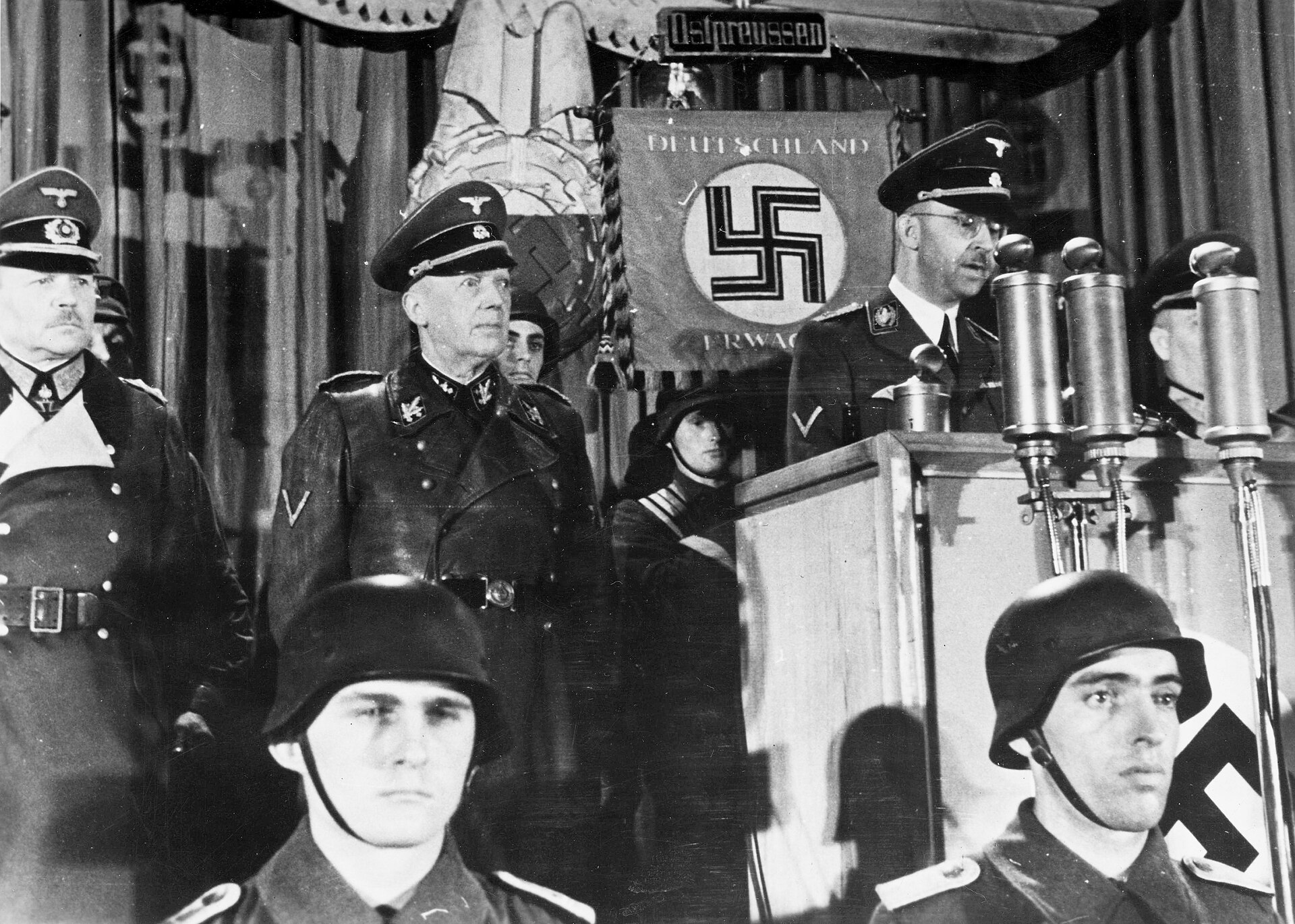 Himmler (at podium) with Heinz Guderian and Hans Lammers in October 1944 On 26 September 1944, Hitler ordered Himmler to create special army units, the Volkssturm ("People's Storm" or "People's Army"). All males aged sixteen to sixty were eligible for conscription into this militia, over the protests of Armaments Minister Albert Speer, who noted that irreplaceable skilled workers were being removed from armaments production.[178] Hitler confidently believed six million men could be raised, and the new units would "initiate a people's war against the invader".[179] These hopes were wildly optimistic.[179] In October 1944, children as young as fourteen were being enlisted. Because of severe shortages in weapons and equipment and lack of training, members of the Volkssturm were poorly prepared for combat, and about 175,000 of them died in the final months of the war.[180] On 1 January 1945, Hitler and his generals launched Operation North Wind. The goal was to break through the lines of the US 7th Army and French 1st Army to support the southern thrust in the Battle of the Bulge (Ardennes offensive), the final major German offensive of the war. After limited initial gains by the Germans, the Americans halted the offensive.[181] By 25 January, Operation North Wind had officially ended. On 25 January 1945, despite Himmler's lack of military experience, Hitler appointed him as commander of the hastily formed Army Group Vistula (Heeresgruppe Weichsel) to halt the Soviet Red Army's Vistula–Oder offensive into Pomerania[182] – a decision that appalled the German General Staff.[183] Himmler established his command centre at Schneidemühl, using his special train, Sonderzug Steiermark, as his headquarters. The train had only one telephone line, inadequate maps, and no signal detachment or radios with which to establish communication and relay military orders. Himmler seldom left the train, only worked about four hours per day, and insisted on a daily massage before commencing work and a lengthy nap after lunch.[184] General Heinz Guderian talked to Himmler on 9 February and demanded that Operation Solstice, an attack from Pomerania against the northern flank of Marshal Georgy Zhukov's 1st Belorussian Front, should be in progress by the 16th. Himmler argued that he was not ready to commit himself to a specific date. Given Himmler's lack of qualifications as an army group commander, Guderian convinced himself that Himmler tried to conceal his incompetence.[185] On 13 February Guderian met Hitler and demanded that General Walther Wenck be given a special mandate to command the offensive by Army Group Vistula. Hitler sent Wenck with a "special mandate", but without specifying Wenck's authority.[186] The offensive was launched on 16 February 1945, but soon stuck in rain and mud, facing mine fields and strong antitank defenses. That night Wenck was severely injured in a car accident, but it is doubtful that he could have salvaged the operation, as Guderian later claimed. Himmler ordered the offensive to stop on the 18th by a "directive for regrouping".[187] Hitler officially ended Operation Solstice on 21 February and ordered Himmler to transfer a corps headquarter and three divisions to Army Group Center.[188] Himmler was unable to devise any viable plans for completion of his military objectives. Under pressure from Hitler over the worsening military situation, Himmler became anxious and unable to give him coherent reports.[189] When the counter-attack failed to stop the Soviet advance, Hitler held Himmler personally liable and accused him of not following orders. Himmler's military command ended on 20 March, when Hitler replaced him with General Gotthard Heinrici as Commander-in-Chief of Army Group Vistula. By this time Himmler, who had been under the care of his doctor since 18 February, had fled to the Hohenlychen Sanatorium.[190] Hitler sent Guderian on a forced medical leave of absence, and he reassigned his post as chief of staff to Hans Krebs on 29 March.[191] Himmler's failure and Hitler's response marked a serious deterioration in the relationship between the two men.[192] By that time, the inner circle of people whom Hitler trusted was rapidly shrinking.[193] Peace negotiations In early 1945, the German war effort was on the verge of collapse and Himmler's relationship with Hitler had deteriorated. Himmler considered independently negotiating a peace settlement. His masseur, Felix Kersten, who had moved to Sweden, acted as an intermediary in negotiations with Count Folke Bernadotte, head of the Swedish Red Cross. Letters were exchanged between the two men,[194] and direct meetings were arranged by Walter Schellenberg of the RSHA.[195] In March 1945, Himmler issued a directive that Jews were to be marched from the South-east wall (Südostwall) fortifications construction project on the Austro-Hungarian border, to Mauthausen. He desired hostages for potential peace negotiations. Thousands died on the marches.[196][197] 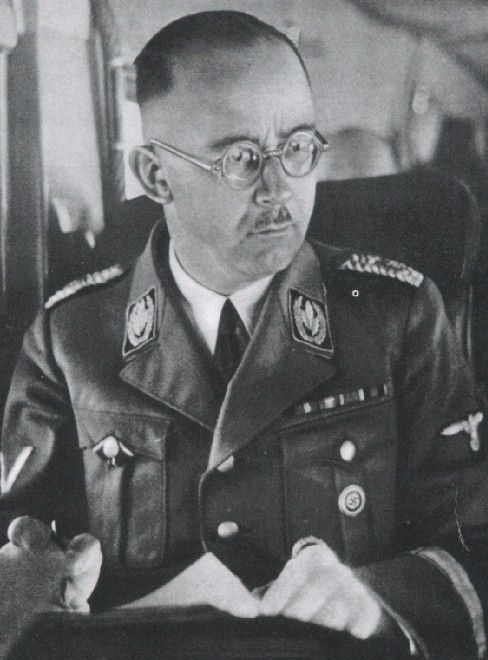 Himmler in 1945 Himmler and Hitler met for the last time on 20 April 1945—Hitler's birthday—in Berlin, and Himmler swore unswerving loyalty to Hitler. At a military briefing on that day, Hitler stated that he would not leave Berlin, in spite of Soviet advances. Along with Göring, Himmler quickly left the city after the briefing.[198] On 21 April, Himmler met with Norbert Masur, a Swedish representative of the World Jewish Congress, to discuss the release of Jewish concentration camp inmates.[199] As a result of these negotiations, about 20,000 people were released in the White Buses operation.[200] Himmler falsely claimed in the meeting that the crematoria at camps had been built to deal with the bodies of prisoners who had died in a typhus epidemic. He also claimed very high survival rates for the camps at Auschwitz and Bergen-Belsen, even as these sites were liberated and it became obvious that his figures were false.[201] On 23 April, Himmler met directly with Bernadotte at the Swedish consulate in Lübeck. Representing himself as the provisional leader of Germany, he claimed that Hitler would be dead within the next few days. Hoping that the British and Americans would fight the Soviets alongside what remained of the Wehrmacht, Himmler asked Bernadotte to inform General Dwight Eisenhower that Germany wished to surrender to the Western Allies, and not to the Soviet Union. Bernadotte asked Himmler to put his proposal in writing, and Himmler obliged.[202][203] Meanwhile, Göring had sent a telegram, a few hours earlier, asking Hitler for permission to assume leadership of the Reich in his capacity as Hitler's designated deputy—an act that Hitler, under the prodding of Martin Bormann, interpreted as a demand to step down or face a coup. On 27 April, Himmler's SS representative at Hitler's HQ in Berlin, Hermann Fegelein, was caught in civilian clothes preparing to desert; he was arrested and brought back to the Führerbunker. On the evening of 28 April, the BBC broadcast a Reuters news report about Himmler's attempted negotiations with the western Allies. Hitler had long considered Himmler to be second only to Joseph Goebbels in loyalty; he called Himmler "the loyal Heinrich" (German: der treue Heinrich). Hitler flew into a rage at this betrayal, and told those still with him in the bunker complex that Himmler's secret negotiations were the worst treachery he had ever known. Hitler ordered Himmler's arrest, and Fegelein was court-martialed and shot.[204] By this time, the Soviets had advanced to the Potsdamer Platz, only 300 m (330 yd) from the Reich Chancellery, and were preparing to storm the Chancellery. This report, combined with Himmler's treachery, prompted Hitler to write his last will and testament. In the testament, completed on 29 April—one day prior to his suicide—Hitler declared both Himmler and Göring to be traitors. He stripped Himmler of all of his party and state offices and expelled him from the Nazi Party.[205][206] Hitler named Grand Admiral Karl Dönitz as his successor. Himmler met Dönitz in Flensburg and offered himself as second-in-command. He maintained that he was entitled to a position in Dönitz's interim government as Reichsführer-SS, believing the SS would be in a good position to restore and maintain order after the war. Dönitz repeatedly rejected Himmler's overtures[207] and initiated peace negotiations with the Allies. He wrote a letter on 6 May—two days before the German Instrument of Surrender—formally dismissing Himmler from all his posts.[208] |
陸軍集団の指揮 1944年6月6日、西側連合軍はオーバーロード作戦でフランス北部に上陸した[175]。これを受けて、ライン川西岸沿いのアルザス地方で進撃するアメ リカ第7軍(アレクサンダー・パッチ将軍指揮[176])とフランス第1軍(ジャン・ド・ラトル・ド・タッシニー将軍率いる)と交戦するためにライン川上 流軍集団(Heeresgruppe Oberrhein)グループが編成された[177]。1944年後半、ヒトラーはライン川上流軍集団の総司令官をヒムラーに任命した。  1944年10月、ハインツ・グーデリアン、ハンス・ランマースとヒムラー(演壇にて)。 1944年9月26日、ヒトラーはヒムラーに特別陸軍部隊「フォルクス・シュトルム」(「人民の嵐」または「人民軍」)の創設を命じた。ヒトラーは、 600 万人の兵士が集められ、新しい部隊が「侵略者に対する人民の 戦争を開始する」ことができると確信していた[179]。武器や装備の深刻な不足と訓練不足のために、フォルクスシュトゥルムのメンバーは戦闘への備えが 不十分であり、戦争末期の数カ月の間に約17万5,000人が死亡した[180]。 1945年1月1日、ヒトラーと将軍たちは北風作戦を開始した。その目的は、米第7軍と仏第1軍の戦線を突破し、バルジの戦い(アルデンヌ攻防戦)におけ る南方への突進を支援することであった。ドイツ軍による最初の獲得が限られた後、アメリカ軍は攻勢を停止した[181]。1月25日までに、北風作戦は正 式に終了した。 1945年1月25日、ヒトラーはヒムラーに軍事経験がないにもかかわらず、ソ連赤軍のポメラニアへのヴィスワ・オデル攻勢を阻止するために急遽編成され たヴィスワ軍集団(Heeresgruppe Weichsel)の司令官に任命した[182]。列車には電話線が1本しかなく、地図も不十分で、通信を確立して軍事命令を伝えるための信号分遣隊も無 線機もなかった。ヒムラーはめったに列車を離れず、1日に4時間ほどしか働かず、毎日仕事を始める前にマッサージをし、昼食の後に長い昼寝をすることにこ だわった[184]。 ハインツ・グデーリアン将軍は2月9日にヒムラーと会談し、ポメラニアからゲオルギー・ジューコフ元帥の第1ベラルーシ戦線の北側面に対する攻撃である夏 至作戦を16日までに実施するよう要求した。ヒムラーは、特定の期日を確約する用意はないと主張した。2月13日、グデーリアンはヒトラーと会談し、ワル テル・ウェンク将軍にヴィスワ軍集団の攻勢を指揮する特別任務を与えるよう要求した。ヒトラーはヴェンクに「特別委任状」を送ったが、ヴェンクの権限は明 示しなかった[186]。攻勢は1945年2月16日に開始されたが、すぐに雨と泥に足をとられ、地雷原と強力な対戦車防御に直面した。その夜、ヴェンク は交通事故で重傷を負ったが、グデーリアンが後に主張したように、彼が作戦を救い出すことができたかどうかは疑わしい。ヒトラーは2月21日に夏至作戦を 正式に終了させ、ヒムラーに軍団本部と3個師団を陸軍集団中央に移管するよう命じた[188]。 ヒムラーは軍事目標を達成するための実行可能な計画を立案することができなかった。反撃がソ連の前進を阻止できなかったとき、ヒトラーはヒムラー個人の責 任を追及し、命令に従わなかったとして彼を非難した[189]。3月20日、ヒトラーはヒムラーに代わってゴットハルト・ハインリキ将軍をヴィスワ軍集団 総司令官に任命し、ヒムラーの軍事指揮は終了した。ヒトラーはグデーリアンを強制的な療養休暇に送り、3月29日に参謀総長のポストをハンス・クレプスに 再指定した[191]。ヒムラーの失敗とヒトラーの対応は、二人の関係の深刻な悪化を意味した[192]。 和平交渉 1945年初頭、ドイツの戦争努力は崩壊寸前であり、ヒムラーとヒトラーの関係は悪化していた。ヒムラーは独自に和平交渉を行うことを考えた。スウェーデ ンに移住していたマッサージ師のフェリックス・ケルステンが仲介役となり、スウェーデン赤十字のフォルケ・ベルナドッテ伯爵と交渉した。二人の間で書簡が 交換され[194]、RSHAのヴァルター・シェレンベルクが直接会談を手配した[195]。 1945年3月、ヒムラーはオーストリア=ハンガリー国境の南東壁(Südostwall)要塞建設プロジェクトからマウトハウゼンまでユダヤ人を行進さ せるという指令を出した。彼は和平交渉のための人質を求めていた。数千人が行軍中に死亡した[196][197]。  1945年のヒムラー ヒムラーとヒトラーは1945年4月20日(ヒトラーの誕生日)にベルリンで最後の会談を行い、ヒムラーはヒトラーへの揺るぎない忠誠を誓った。その日の 軍事ブリーフィングでヒトラーは、ソ連の進撃にもかかわらずベルリンを離れないと明言した。4月21日、ヒムラーは世界ユダヤ人会議のスウェーデン代表ノ ルベルト・マスールとユダヤ人強制収容所収容者の解放について会談した[199]。 この交渉の結果、白バス作戦で約2万人が解放された[200]。彼はまた、アウシュヴィッツとベルゲン・ベルゼンの収容所の生存率が非常に高いと主張した が、これらの収容所が解放され、彼の数字が虚偽であることが明らかになったときでさえもであった[201]。 4月23日、ヒムラーはリューベックのスウェーデン領事館でベルナドッテと直接会談した。自らをドイツの暫定的指導者として表し、ヒトラーは数日以内に死 ぬだろうと主張した。英米が国防軍の残存部隊とともにソビエトと戦うことを望んでいたヒムラーは、ベルナドッテに、ドイツはソ連ではなく西側連合国に降伏 することを望んでいるとドワイト・アイゼンハワー将軍に伝えるよう依頼した。ベルナドッテはヒムラーに自分の提案を書面にするよう求め、ヒムラーはそれに 応じた[202][203]。 一方、ゲーリングはその数時間前にヒトラーに電報を送り、ヒトラーの指名した副官として帝国の指導者に就任する許可を求めていた。4月27日、ベルリンの ヒトラー本部にいたヒムラーの親衛隊代表ヘルマン・フェゲラインは、私服姿で脱走の準備をしているところを捕まった。4月28日の夜、BBCはヒムラーが 西側連合国との交渉を試みたというロイターのニュースを放送した。ヒトラーは長い間、ヒムラーのことをヨーゼフ・ゲッベルスに次ぐ忠誠心の持ち主と考えて おり、ヒムラーのことを「忠実なハインリヒ」(ドイツ語ではder treue Heinrich)と呼んでいた。ヒトラーはこの裏切り行為に激怒し、ヒムラーの秘密交渉は最悪の裏切り行為であると、地下壕に残っていた関係者に告げ た。ヒトラーはヒムラーの逮捕を命じ、フェゲラインは軍法会議にかけられ、銃殺された[204]。 その頃、ソビエト軍は大総統官邸からわずか300メートルしか離れていないポツダム広場まで前進しており、総統官邸を襲撃する準備をしていた。この報告と ヒムラーの裏切りによって、ヒトラーは遺言状を書くことになった。ヒトラーは、自殺の前日である4月29日に完成した遺言の中で、ヒムラーとゲーリングの 両名を裏切り者であると宣言した。ヒトラーはヒムラーから党と国家の役職をすべて剥奪し、ナチ党から追放した[205][206]。 ヒトラーはカール・デーニッツ大提督を後継者に指名した。ヒムラーはフレンスブルクでデーニッツに会い、副官として自らを申し出た。彼は、親衛隊が戦後の 秩序を回復し維持するのに有利な立場にあると考え、デーニッツの帝国親衛隊総統としての暫定政府での地位を得る権利が自分にあると主張した。デーニッツは ヒムラーの申し出を繰り返し拒否し[207]、連合国との和平交渉を開始した。ドイツの降伏文書が提出される2日前の5月6日、彼はヒムラーをすべてのポ ストから解任する書簡を書いた[208]。 |
Capture and death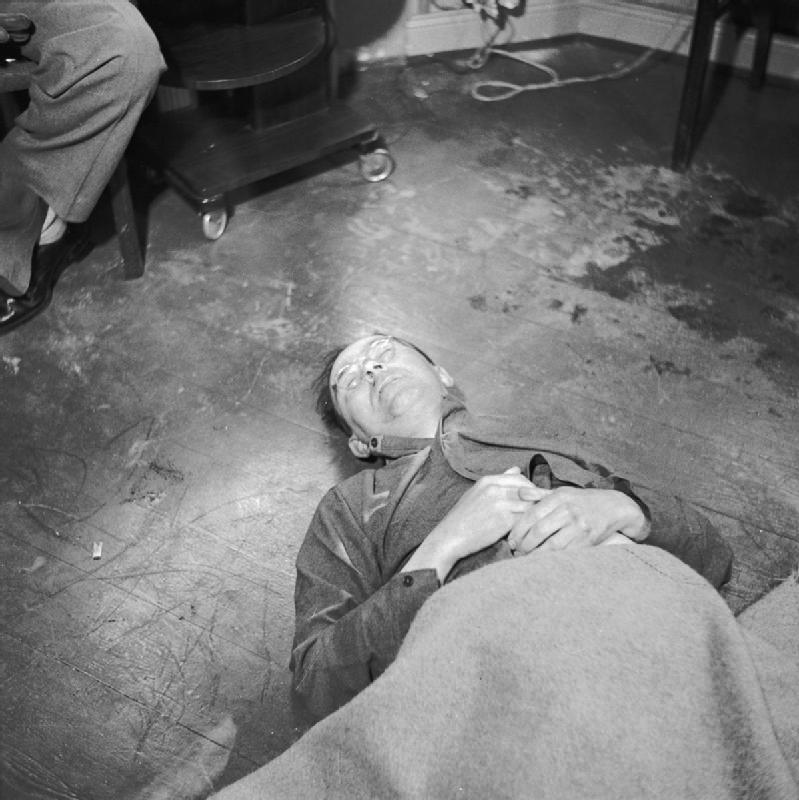 Himmler's corpse after his suicide by cyanide poisoning, May 1945 Rejected by his former comrades and hunted by the Allies, Himmler attempted to go into hiding. He had not made extensive preparations for this, but he carried a forged paybook under the name of Sergeant Heinrich Hizinger. On 11 May 1945, with a small band of companions, he headed south to Friedrichskoog, without a final destination in mind. They continued on to Neuhaus, where the group split up. On 21 May, Himmler and two aides were stopped and detained at a checkpoint in Bremervörde set up by former Soviet POWs. Over the following two days, he was moved around to several camps[209] and was brought to the British 31st Civilian Interrogation Camp near Lüneburg, on 23 May.[210] The officials noticed that Himmler's identity papers bore a stamp which British military intelligence had seen being used by fleeing members of the SS.[211] The duty officer, Captain Thomas Selvester, began a routine interrogation. Himmler admitted who he was, and Selvester had the prisoner searched. Himmler was taken to the headquarters of the Second British Army in Lüneburg, where a doctor conducted a medical exam on him. The doctor attempted to examine the inside of Himmler's mouth, but the prisoner was reluctant to open it and jerked his head away. Himmler then bit into a hidden potassium cyanide pill and collapsed onto the floor. He was dead within 15 minutes,[212][213] despite efforts to expel the poison from his system.[214] Shortly afterward, Himmler's body was buried in an unmarked grave near Lüneburg. The grave's location remains unknown.[215] |
捕縛と死 青酸中毒で自殺したヒムラーの死体(1945年5月 かつての仲間に拒絶され、連合国に追われる身となったヒムラーは潜伏を試みた。そのための大がかりな準備はしていなかったが、ハインリヒ・ヒジンガー軍曹 の名前で偽造した給与手帳を携帯していた。1945年5月11日、彼は少数の仲間とともに、最終目的地を決めずにフリードリヒスコーグを目指して南下し た。そのままノイハウスまで行き、そこで一行は別れた。5月21日、ヒムラーと2人の側近は旧ソ連軍捕虜が設置したブレーマーヴェルデの検問所に止めら れ、拘束された。その後の2日間、彼はいくつかの収容所を転々とし[209]、5月23日にリューネブルク近郊のイギリス第31民間人尋問収容所に連行さ れた[210]。職員たちは、ヒムラーの身分証明書にイギリス軍情報部が逃亡中のSSメンバーが使用しているのを目撃したスタンプが押されていることに気 づいた[211]。 当直将校のトーマス・セルヴェスター大尉は定例の尋問を開始した。ヒムラーは自分が誰であるかを認め、セルヴェスターは囚人を身体検査した。ヒムラーは リューネブルクの第二イギリス軍司令部に連行され、そこで医師が彼の健康診断を行った。医師はヒムラーの口の中を調べようとしたが、囚人は口を開けようと せず、首を横に振った。そしてヒムラーは隠し持っていたシアン化カリウムの錠剤をかじり、床に倒れた。その後まもなく、ヒムラーの遺体はリューネブルク近 郊の無名の墓に埋葬された[212][213]。墓の場所は不明のままである[215]。 |
| Mysticism and symbolism Main articles: Ideology of the SS and Occultism in Nazism 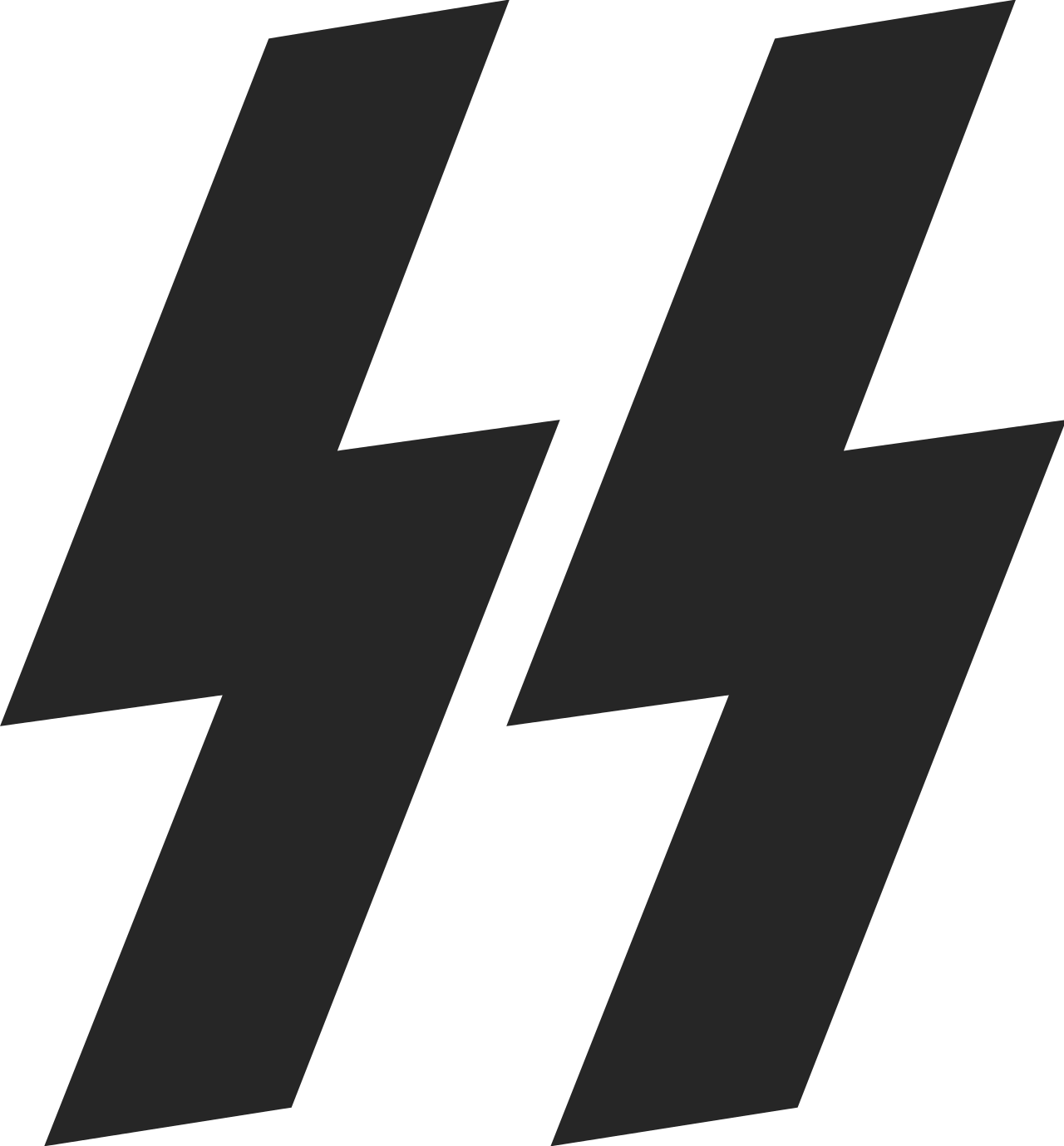 The stylised lightning bolts of the SS insignia were based on the Armanen runes of Guido von List. Himmler was interested in mysticism and the occult from an early age. He tied this interest into his racist philosophy, looking for proof of Aryan and Nordic racial superiority from ancient times. He promoted a cult of ancestor worship, particularly among members of the SS, as a way to keep the race pure and provide immortality to the nation. Viewing the SS as an "order" along the lines of the Teutonic Knights, he had them take over the Church of the Teutonic Order in Vienna in 1939. He began the process of replacing Christianity with a new moral code that rejected humanitarianism and challenged the Christian concept of marriage.[216] The Ahnenerbe, a research society founded by Himmler in 1935, searched the globe for proof of the superiority and ancient origins of the Germanic race.[217][218] All regalia and uniforms of Nazi Germany, particularly those of the SS, used symbolism in their designs. The stylised lightning bolt logo of the SS was chosen in 1932. The logo is a pair of runes from a set of 18 Armanen runes created by Guido von List in 1906. The ancient Sowilō rune originally symbolised the sun, but was renamed "Sieg" (victory) in List's iconography.[219] Himmler modified a variety of existing customs to emphasise the elitism and central role of the SS; an SS naming ceremony was to replace baptism, marriage ceremonies were to be altered, a separate SS funeral ceremony was to be held in addition to Christian ceremonies, and SS-centric celebrations of the summer and winter solstices were instituted.[220][221] The Totenkopf (death's head) symbol, used by German military units for hundreds of years, had been chosen for the SS by Julius Schreck.[222] Himmler placed particular importance on the death's-head rings; they were never to be sold, and were to be returned to him upon the death of the owner. He interpreted the death's-head symbol to mean solidarity to the cause and a commitment unto death.[223] |
神秘主義と象徴主義 主な記事 SSのイデオロギーとナチズムにおけるオカルティズム  SS徽章の様式化された稲妻は、グイド・フォン・リストのアルマネン・ルーン文字に基づいている。 ヒムラーは幼い頃から神秘主義とオカルトに興味を持っていた。彼はこの興味を人種差別思想に結びつけ、アーリア人と北欧人の人種的優位性を古代から証明す るものを探した。彼は、民族を純粋に保ち、国家に不滅をもたらす方法として、特に親衛隊のメンバーの間で祖先崇拝のカルトを推進した。SSをチュートン騎 士団の流れを汲む「騎士団」とみなし、1939年にはウィーンのチュートン騎士団教会を占領させた。ヒムラーが1935年に設立した研究団体アーネンナー ベは、ゲルマン民族の優越性と古代の起源を証明するものを世界中に探した[217][218]。 ナチス・ドイツのすべてのレガリアと制服、特に親衛隊の制服は、そのデザインに象徴主義が用いられていた。親衛隊の様式化された稲妻のロゴは1932年に 選ばれた。このロゴは、1906年にグイド・フォン・リストが作成した18個のアーマネン・ルーン(ルーン文字)のセットから選ばれたものである。ヒム ラーはSSのエリート主義と中心的役割を強調するために、既存の様々な慣習を修正した。洗礼式に代わってSSの命名式が行われ、結婚の儀式が変更され、キ リスト教の儀式に加えて別のSSの葬儀が行われ、夏至と冬至のSS中心の祝典が制定された。 [ヒムラーは死者の頭の指輪を特に重要視し、決して売ってはならず、所有者の死後は返還されることになっていた。彼は死者の頭のシンボルを、大義への連帯 と死へのコミットメントを意味すると解釈した[223]。 |
| Relationship with Hitler As second in command of the SS and then Reichsführer-SS, Himmler was in regular contact with Hitler to arrange for SS men as bodyguards;[224] Himmler was not involved with Nazi Party policy-making decisions in the years leading up to the seizure of power.[225] From the late 1930s, the SS was independent of the control of other state agencies or government departments, and he reported only to Hitler.[226] Hitler promoted and practised the Führerprinzip. The principle required absolute obedience of all subordinates to their superiors; thus Hitler viewed the government structure as a pyramid, with himself—the infallible leader—at the apex.[227] Accordingly, Himmler placed himself in a position of subservience to Hitler, and was unconditionally obedient to him.[228] However, he—like other top Nazi officials—had aspirations to one day succeed Hitler as leader of the Reich.[229] Himmler considered Speer to be an especially dangerous rival, both in the Reich administration and as a potential successor to Hitler.[230] Hitler called Himmler's mystical and pseudoreligious interests "nonsense".[231] Himmler was not a member of Hitler's inner circle; the two men were not very close, and rarely saw each other socially.[232][233] Himmler socialised almost exclusively with other members of the SS.[234] His unconditional loyalty and efforts to please Hitler earned him the nickname of der treue Heinrich ("the faithful Heinrich"). However, in the last days of the war, when it became clear that Hitler planned to die in Berlin, Himmler left his long-time superior to try to save himself.[235] |
ヒトラーとの関係 ヒムラーは親衛隊の副司令官として、また親衛隊総統として、ヒトラーと定期的に連絡を取り合い、親衛隊員をボディーガードとして手配していた[224]。 1930年代後半から、親衛隊は他の国家機関や政府部門の統制から独立し、ヒトラーにのみ報告した[226]。 ヒトラーは総統プリンツィップを推進し、実践した。この原則は、すべての部下が上司に絶対服従することを求めていた。したがってヒトラーは、政府機構を、 無謬の指導者である自らを頂点とするピラミッドとみなしていた[227]。したがって、ヒムラーは自らをヒトラーに従属する立場に置き、ヒトラーに無条件 に服従していた。 [228]しかし、他のナチス幹部と同様に、彼はいつかヒトラーの後継者として帝国の指導者になることを熱望していた[229]。ヒムラーは、シュペーア を帝国の行政においても、ヒトラーの後継者となりうる人物としても、特に危険なライバルと考えていた[230]。 ヒトラーはヒムラーの神秘主義的で偽宗教的な興味を「ナンセンス」と呼んだ[231]。ヒムラーはヒトラーの側近ではなく、2人はあまり親密ではなく、社 交的に顔を合わせることはほとんどなかった[232][233]。しかし、戦争末期、ヒトラーがベルリンで死ぬ予定であることが明らかになると、ヒムラー は自分自身を救うために長年の上司のもとを去った[235]。 |
Marriage and family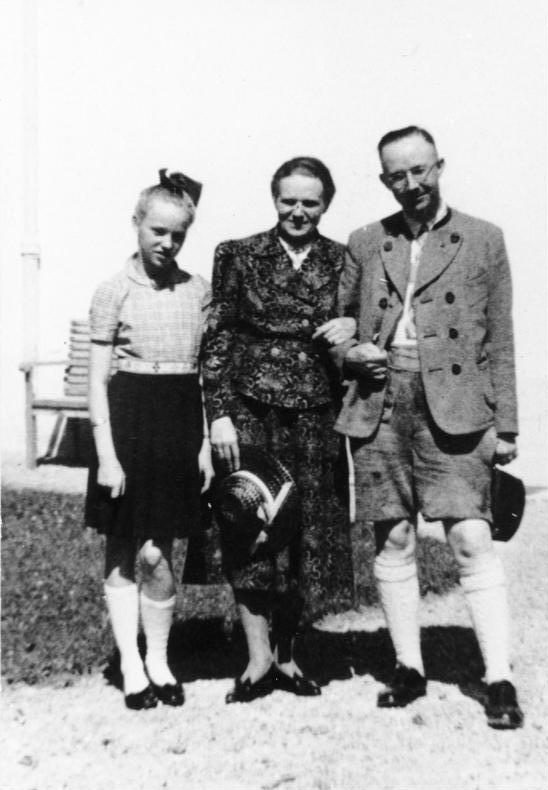 Himmler with his wife Margarete and daughter Gudrun Himmler met his future wife, Margarete Boden, in 1927. Seven years his senior, she was a nurse who shared his interest in herbal medicine and homoeopathy, and was part owner of a small private clinic. They were married in July 1928, and their only child, Gudrun, was born on 8 August 1929.[236] The couple were also foster parents to a boy named Gerhard von Ahe, son of an SS officer who had died before the war.[237] Margarete sold her share of the clinic and used the proceeds to buy a plot of land in Waldtrudering, near Munich, where they erected a prefabricated house. Himmler was constantly away on party business, so his wife took charge of their efforts—mostly unsuccessful—to raise livestock for sale. They had a dog, Töhle.[238] After the Nazis came to power the family moved first to Möhlstrasse in Munich, and in 1934 to Tegernsee, where they bought a house. Himmler also later obtained a large house in the Berlin suburb of Dahlem, free of charge, as an official residence. The couple saw little of each other as Himmler became totally absorbed by work.[239] The relationship was strained.[240][241] The couple did unite for social functions; they were frequent guests at the Heydrich home. Margarete saw it as her duty to invite the wives of the senior SS leaders over for afternoon coffee and tea on Wednesday afternoons.[242]  Himmler and his daughter Gudrun Hedwig Potthast, Himmler's young secretary starting in 1936, became his mistress by 1939. She left her job in 1941. He arranged accommodation for her, first in Mecklenburg and later at Berchtesgaden. He fathered two children with her: a son, Helge (born 15 February 1942, Mecklenburg) and a daughter, Nanette Dorothea (born 20 July 1944, Berchtesgaden). Margarete, by then living in Gmund with her daughter, learned of the relationship sometime in 1941; she and Himmler were already separated, and she decided to tolerate the relationship for the sake of her daughter. Working as a nurse for the German Red Cross during the war, Margarete was appointed supervisor in one of Germany's military districts, Wehrkreis III (Berlin-Brandenburg). Himmler was close to his first daughter, Gudrun, whom he nicknamed Püppi ("dolly"); he phoned her every few days and visited as often as he could.[243] Margarete's diaries record that Gerhard left the National Political Educational Institute in Berlin due to poor examination results. At 16 he joined the SS in Brno and fought on the Eastern Front. He was captured by the Russians but was later returned to Germany.[244] Hedwig and Margarete both remained loyal to Himmler. Writing to Gebhard in February 1945, Margarete said, "How wonderful that he has been called to great tasks and is equal to them. The whole of Germany is looking to him."[245] Hedwig expressed similar sentiments in a letter to Himmler in January. Margarete and Gudrun left Gmund as Allied troops advanced into the area. They were arrested by American troops in Bolzano, Italy, and held in various internment camps in Italy, France, and Germany. They were brought to Nuremberg to testify at the trials and were released in November 1946. Gudrun emerged from the experience embittered by her alleged mistreatment and remained devoted to her father's memory.[246][247] She later worked for the West German spy agency Bundesnachrichtendienst (BND) from 1961 to 1963.[248] |
結婚と家族 ヒムラーと妻マルガレーテ、娘グドルン ヒムラーは1927年、後に妻となるマルガレーテ・ボーデンと出会った。7歳年上の彼女は看護師で、薬草療法とホメオパシーに興味を持ち、小さな個人クリ ニックのオーナーでもあった。二人は1928年7月に結婚し、1929年8月8日に一人息子のグドルンが生まれた[236]。マルガレーテは診療所の株を 売却し、その資金でミュンヘン近郊のヴァルトルーダリングに土地を購入し、プレハブの家を建てた[237]。ヒムラーは常に党の仕事で不在だったため、妻 は販売用の家畜の飼育を担当した。彼らは犬のテーレを飼っていた[238]。 ナチスが政権を握った後、一家はまずミュンヘンのメールシュトラッセに移り、1934年にはテーゲルンゼーに家を購入した。ヒムラーはその後、ベルリン郊 外のダーレムに公邸として大きな家を無償で手に入れた。ヒムラーが仕事に没頭するようになると、夫妻はほとんど顔を合わせなくなった[239]。 夫妻の関係はぎくしゃくしたものであった[240][241]。マルガレーテは、水曜日の午後に親衛隊幹部の妻たちを午後のコーヒーと紅茶に招待すること を義務と考えていた[242]。  ヒムラーとその娘グドルン 1936年にヒムラーの若い秘書となったヘドヴィヒ・ポッタストは、1939年には彼の愛人となった。彼女は1941年に仕事を辞めた。彼は彼女のため に、最初はメクレンブルクに、後にベルヒテスガーデンに宿舎を用意した。息子のヘルゲ(1942年2月15日、メクレンブルク生まれ)と娘のナネット・ド ロテア(1944年7月20日、ベルヒテスガーデン生まれ)である。ヒムラーとはすでに別居していたが、娘のために関係を容認することにした。戦時中、ド イツ赤十字の看護婦として働いていたマルガレーテは、ドイツの軍管区のひとつであるヴェアクライスIII(ベルリン=ブランデンブルク)の監督官に任命さ れた。ヒムラーはピュッピ(「ドリー」)とあだ名された長女グドルンと親しく、数日おきに電話をかけ、できる限り頻繁に訪問した[243]。 マルガレーテの日記によると、ゲルハルトは試験の結果が悪かったため、ベルリンの国立政治教育研究所を退学した。16歳でブルノのSSに入隊し、東部戦線 で戦った。ロシア軍の捕虜となったが、後にドイツに戻された[244]。 ヘドヴィヒとマルガレーテはヒムラーに忠誠を誓った。1945年2月にゲバルトに宛てた手紙の中で、マルガレーテは「彼が偉大な任務に召され、それにふさ わしいとは、なんと素晴らしいことでしょう。ドイツ全土が彼に注目しています」[245] ヘドヴィヒも1月のヒムラーへの手紙で同様の感想を述べている。マルガレーテとグドゥルンは、連合軍がこの地域に進攻してきたため、グムントを離れた。彼 らはイタリアのボルツァーノでアメリカ軍に逮捕され、イタリア、フランス、ドイツのさまざまな収容所に収容された。裁判での証言のためにニュルンベルクに 連れて行かれ、1946年11月に釈放された。グドゥルンはこの経験から、虐待を受けたとされることに憤慨し、父の思い出に献身し続けた[246] [247]。その後、1961年から1963年まで西ドイツのスパイ機関BND(Bundesnachrichtendienst)に勤務した [248]。 |
| Historical assessment Peter Longerich observes that Himmler's ability to consolidate his ever-increasing powers and responsibilities into a coherent system under the auspices of the SS led him to become one of the most powerful men in the Third Reich.[249] Historian Wolfgang Sauer says that "although he was pedantic, dogmatic, and dull, Himmler emerged under Hitler as second in actual power. His strength lay in a combination of unusual shrewdness, burning ambition, and servile loyalty to Hitler."[250] In 2008, the German news magazine Der Spiegel described Himmler as one of the most brutal mass murderers in history and the architect of the Holocaust.[251] Historian John Toland relates a story by Günter Syrup, a subordinate of Heydrich. Heydrich showed him a picture of Himmler and said: "The top half is the teacher, but the lower half is the sadist."[252] Historian Adrian Weale comments that Himmler and the SS followed Hitler's policies without question or ethical considerations. Himmler accepted Hitler and Nazi ideology and saw the SS as a chivalric Teutonic order of new Germans. Himmler adopted the doctrine of Auftragstaktik ("mission command"), whereby orders were given as broad directives, with authority delegated downward to the appropriate level to carry them out in a timely and efficient manner. Weale states that the SS ideology gave the men a doctrinal framework, and the mission command tactics allowed the junior officers leeway to act on their own initiative to obtain the desired results.[253] |
歴史的評価 ペーター・ロンゲリヒは、ヒムラーは増大し続ける権限と責任を親衛隊の後援のもとで首尾一貫したシステムに統合する能力によって、第三帝国で最も権力を持 つ人物のひとりとなったと述べている[249]。彼の強みは、並外れた抜け目のなさ、燃えるような野心、ヒトラーへの従順な忠誠心の組み合わせにあった」 [250]。2008年、ドイツのニュース雑誌『シュピーゲル』は、ヒムラーを歴史上最も残忍な大量殺人者の一人であり、ホロコーストの立役者であると評 した[251]。 歴史家ジョン・トーランドは、ハイドリヒの部下であったギュンター・シロップの話を紹介している。ハイドリヒは彼にヒムラーの写真を見せて言った: 「上半身は教師だが、下半身はサディストだ」[252] 歴史家エイドリアン・ウィールは、ヒムラーと親衛隊は疑問や倫理的配慮なしにヒトラーの政策に従ったとコメントしている。ヒムラーはヒトラーとナチスのイ デオロギーを受け入れ、親衛隊を新しいドイツ人による騎士道的なチュートニック秩序と見なした。ヒムラーはAuftragstaktik(「任務指揮」) の教義を採用し、それによって命令は広範な指令として与えられ、それを適時に効率的に実行するために適切なレベルまで権限が委譲された。ウィールは、親衛 隊のイデオロギーが隊員に教義の枠組みを与え、任務指揮の戦術が下士官に、望ましい結果を得るために自発的に行動する自由を与えたと述べている [253]。 |
| Glossary of Nazi Germany Heinrich Himmler papers Lebensborn List of Nazi Party leaders and officials List of SS personnel |
ナチス・ドイツ用語集 ハインリヒ・ヒムラー文書 リーベンスボルン ナチ党指導者・幹部リスト ナチス親衛隊員リスト |
| https://en.wikipedia.org/wiki/Heinrich_Himmler |
1900 10月7日、ドイツ帝国領邦バイエルン王 国の首都ミュンヘンのヒルデガルト通りのアパートで生まれる(ハインリッヒ・ヒム ラー 1900-1945)
1915 兄ゲプハルトとともにランツフートの「青 少年軍」(Jugendwehr) の活動に参加。17歳になった兄ゲプハルトが予備軍 (Landsturm) に入隊し、1918年4月に西部戦線へ送られた
1917 バイエルン王国の第11歩兵連隊「フォ ン・デア・タン」に入隊
1918 6月15日から9月15日までフライジン グで士官候補生としてのコースを修め、9月15日から10月1日までバイロイトのバイエルン第17機関銃中隊で機関銃教練を受けた。11月11日にはドイ ツは降伏し、第一次世界大戦が終結した。
1919 4月には反革命義勇軍(フライコール)の 一部隊であるラウターバッハ義勇軍 (Freikorps Lauterbach) に加わって社会主義者が立ち上げたバイエルン・レーテ共和国打倒の軍に従軍
1921 ナチ党は主要な行政官庁から女性は排除されるべきとアナウンスする(Charu
Gupta, Politics
of Gender: Women in Nazi Germany. Economic and Political Weekly.
Vol. 26, No. 17 (Apr. 27, 1991), pp. WS40-WS48 (9 pages))
1923 8月、党員番号14303で国家社会主義 ドイツ労働者党に入党
1925 1924年末にヒトラーが釈放され、 1925年2月にナチ党が再建されると、シュトラッサーとともにナチ党へと戻った。8月8日に親衛隊(SS)に入隊(隊員番号168)
1926 1月A・トムセン『諸民族の消長』を読む
1928 ブロンベルクの地主の娘で看護婦のマルガ レーテ・ボーデン(ドイツ語版)と結婚
1929 第3代親衛隊全国指導者に任命される
1932
1月25日にはヒムラーは党本部建物であ る褐色の家の警備を任され、「共産主義者と警察の妨害から党活動を守る」任務を与えられた。
親衛隊全国指導者ハインリヒ・ヒムラーは、1932
年12月に親衛隊の様々な事務をこなす部局として「親衛隊部」(SS-
Amt)を創設した。
1933
3月17日にヒムラーはヒトラーをボ ディーガードする警護部隊の創設を命じられ、親衛隊の精鋭117名を選抜して「SS司令部衛兵班ベルリン」(SS-Stabswache Berlin) を創設させた。指揮官にはヨーゼフ・ディートリヒを任じた。
7月結婚奨励法の可決。ベビー・ボーナス。中絶手術
の実質的禁止。ナチの政権掌握の直前には、10万人の女性教師と3,000人の女性医師がいたが、最終的に解雇か辞任に追いやられる。(1936年以降は
禁止。大学は10%まで)
1934
ゲーリングはヒムラーに対して譲歩した。1934年 4月20日、ディールスのゲシュタポ局長 (Leiter des Geheimen Staatspolizeiamtes) の上位職として「ゲシュタポ監査官及び長官代理」 (Inspekteur und stellvertretender Chef des Geheimen Staatspolizeiamtes) を新設し、ヒムラーをこれに任じたのであった。ヒムラーは直ちにゲーリングの息のかかったディールスをゲシュタポ局長から解任し[85]、後任にハイドリ ヒをゲシュタポ局長に据えた。ゲーリングは1935年11月20日までゲシュタポのトップであるゲシュタポ長官 (Chef des Geheimen Staatspolizeiamtes) の座に留任したがすでに形式的な存在であり、実質的なゲシュタポ指揮権はゲーリングからヒムラーに引き渡されてい た。
6月30日に行われた粛清事件「長いナイフの夜」に おいて親衛隊はレーム以下突撃隊幹部の逮捕と処刑の実行部隊となった。親衛隊はこの「功績」によって、1934年7月20日付けのヒトラーの指令により突 撃隊から独立した党内組織として認められた。国軍 (Reichswehr) と争っていた突撃隊幹部は長いナイフの夜事件において粛清された。突撃隊の粛清にあたったのはヒムラーら親衛隊であり、この件で親衛隊は国軍の軍部から高 い評価を得ることとなった。ヒトラーは親衛隊の中に軍隊を置くことを模索するようになった。国防相ヴェルナー・フォン・ブロンベルクは親衛隊が三連隊の軍 隊を保有することを承認した[123]。これを承けてヒトラーは、1934年9月24日に三軍司令官に対して、国軍をドイツ唯一の国防組織と認めつつ、武 装した親衛隊部隊を三連隊と一通信隊を置くことを通達した。この通達に基づき設置されたのが親衛隊特務部隊であった[123]。特務部隊は戦時には陸軍の 司令権限を認めつつ、平時にはヒムラーが指揮を執るとされた。特務部隊の扱いは軍隊と同等であり、特務部隊の隊員は給与支給帳 (Soldbuch) と軍歴手帳 (Wehrpaß) の所持を認められて軍人扱いを受けた。
「長いナイフの夜」の後、すべての強制収容所は親衛 隊の管轄となり、ヒムラーは、ダッハウ強制収容所の所長だったテオドール・アイケを全強制収容所監督官、親衛隊髑髏部隊(強制収容所看守部隊)総監に任命 した.
ヒトラー「わが国家では、母親はもっとも重要な公民
である」(Know
about the role of women in Hitler's Reich, that of a child-bearers
changed to workers in anti-aircraft service and emergency workers for
the German army)。また、女性労働者は、マルクス主義の陰謀と、それを嫌悪した。
1935
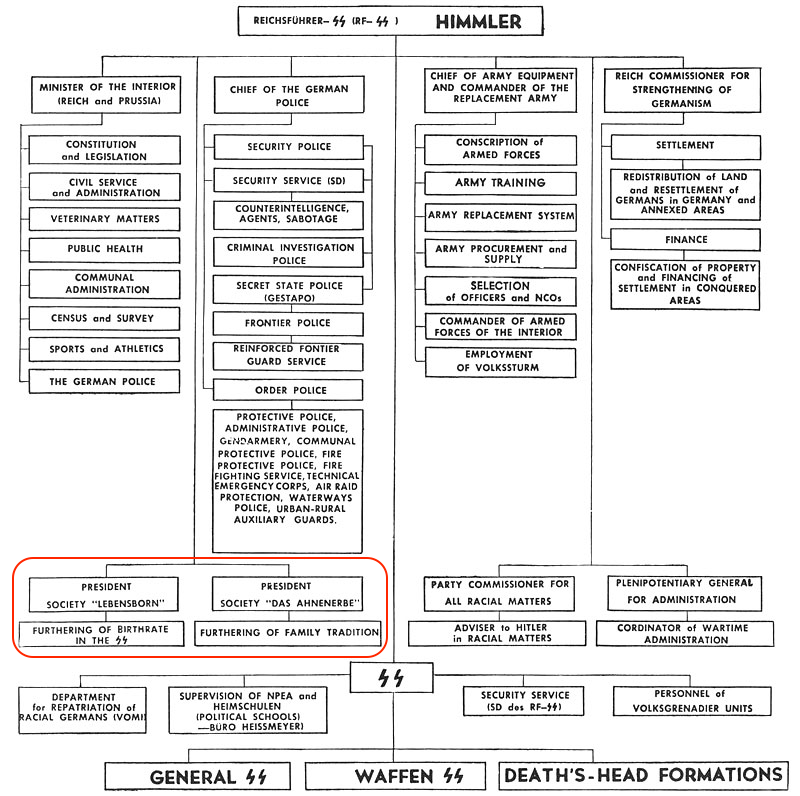 1月30日、親衛隊の機構に本部(Hauptamt)制度が導入されることになった後、真っ先に親衛隊部(SS-Amt)が親衛隊本部(SS-Hauptamt)に昇格した。当初は、まさに親衛隊の「本
部」であり、親衛隊の隊員の人事、親衛隊裁判所、強制収容所、一般親衛隊、政治予備隊(後に親衛隊特務部隊、武装親衛隊となる組織)、国境警備隊、親衛隊
士官学校、隊員の訓練、隊員の福祉、など幅広く所管する部署だった
1月30日、親衛隊の機構に本部(Hauptamt)制度が導入されることになった後、真っ先に親衛隊部(SS-Amt)が親衛隊本部(SS-Hauptamt)に昇格した。当初は、まさに親衛隊の「本
部」であり、親衛隊の隊員の人事、親衛隊裁判所、強制収容所、一般親衛隊、政治予備隊(後に親衛隊特務部隊、武装親衛隊となる組織)、国境警備隊、親衛隊
士官学校、隊員の訓練、隊員の福祉、など幅広く所管する部署だった
1935年12月12日レーベンスボルン協会の発足。ハインリッヒ・ヒ ムラー(このページ)は同年「アーネンエアベ協会(アーネンエルベ協会)」も設立し ている。は、レーベンスボルン協会は女性による健全な北方人種の出産と母子保護 をめざして設立され、アーネンエアベ協会は、北方人種あるいはアーリア人の優秀さを、優生学 と人類学の理論で証明し、かつ、探検隊を組織して実証による証明をおこなおうとした。レー ベンスボルン協会は、「主に未婚の母親に福祉を提供 し、未婚女性による産院での匿名出産を奨励し、同じく「人種的に純粋」で「健康な」親、特にSS隊員とその家族がこれらの子供を養子にする仲介を行った」。 しばしば、人種検査に合格した、北方人種の親衛隊員と未婚の女性と性交し、その後に、女性の出産と子供の養育を目的としたために「交尾の家」と揶揄される こともあった(クレイとリープマン1997)。
1936
6月17日、ヒムラーは全ドイツ警察長官 (Chef der Deutschen Polizei) に任じられた。彼はこれを機に警察組織を統合・再編成し、一般警察業務を行う警察部 署として秩序警察を発足させ、親衛隊大将ダリューゲを長官に任じた [105]。一方政治警察のゲシュタポと刑事警察は保安警察として統合し、ハイドリ ヒをその長官に任じた。
1936年9月にザクセンハウゼン強制収容所 [109]、1937年7月末にブーヘンヴァルト強制収容所[110]、1938年8月にマウトハウゼン強制収容所、1938年11月にフロッセンビュル ク強制収容所、1939年5月にラーフェンスブリュック強制収容所が創設された[111]。
1936年9月13日に、ヒムラーは、レーベンスボ
ルン協会をSSの直接管理のもとにおく。
ヒトラー内閣発足以降、親衛隊はノルトラント出版社 (ドイツ語版)、ドイツ土石製造有限会社 (DEST)、ドイツ装備製造有限会社 (DAW)など、様々な企業経営も行っていた。海軍の主計将校であったオスヴァルト・ポールを親衛隊本部の経済部門の部長に任じ、彼にこれらの企業の経営 を任せた。親衛隊企業の労働力の多くは強制収容所の囚人をもって充てられ、アイケの強制収容所監視官の地位もポールの下に置かれていた。ヒムラーは親衛隊 企業の中では磁器製造会社の経営に強く関心を示していた。同会社は彼が経営にちょくちょく口を出していたためか常に赤字で、会計士からも常に再編や廃業の 勧告を受けていたが最後まで聞き入れず、経営を続けた[116]。

Himmler visiting the
Dachau concentration camp in 1936, Bundesarchiv, Bild 152-11-12 /
CC-BY-SA 3.0
10月1日、ヒムラーは親衛隊特務部隊の管理のた
め、パウル・ハウサーを長とする親衛隊特務部隊総監部を創設させた
1938-1939
開戦前から戦争初期にかけてヒムラー以下親衛隊はユ ダヤ人の国外追放を行っていた。1938年にオーストリアの「ユダヤ人移民局」の局長になったSDユダヤ人課のアドルフ・アイヒマンが注目され、1939 年1月にはベルリン内務省内に「ユダヤ人移住中央本部」が設置されてアイヒマン方式が全国に拡大された。1939年10月7日にはヒムラーはドイツ民族性 強化国家委員 (Reichskommissar für die Festigung des deutschen Volkstums) に任命された[134][135]。この権限に基づき、彼は親衛隊の本部の一つとして「ドイツ民族性強化国家委員本部」(RKFDV) を設置し、親衛隊大将ウルリヒ・グライフェルトを本部長に任じた。アーリア人の支配民族思想に基づいてヨーロッパ・ユダヤ人の東方への植民・強制移住政策 を推し進めた。1939年9月のポーランド侵攻後、国家保安本部は占領下ポーランドやソ連占領地域にアインザッツグルッペン(特別行動部隊)を派遣してユ ダヤ人を含む反体制ポーランド住民を銃殺した。しかしながらこの時期に親衛隊がユダヤ人の絶滅を計画していたわけではないと見られている。ヒムラーも 1940年5月に「ユダヤ人根絶のボルシェヴィキ的方法は信念として非ゲルマン的であるし、不可能である」と述べている[136]。ユダヤ人絶滅政策(ホ ロコースト)の決定はヒムラーではなくアドルフ・ヒトラーによるものと考えられている。
ユダヤ人女性への中絶は合法との判決。
1939
8月、ヒトラーからポーランド侵攻の口実を作るよう
命じられたヒムラーは、ハイドリヒに計画を策定させた。こうして1939年8月31日にSDにより実行に移されることになるのがグライヴィッツ事件であっ
た。この作戦は「ヒムラー作戦」と命名されていた。SD工作員アルフレート・ナウヨックスがポーランド軍人に成りすましてポーランドのグライヴィッツ放送
局を占拠し、反独演説を行った。この事件を口実に、ヒトラーは「いまやドイツとポーランドは戦争状態に入った」としてポーランドとの戦争を国会において宣
言したのであった[126]。
9月27日にはハイドリヒの傘下にあったSDと保安 警察を統合させて、国家保安本部 (RSHA) を親衛隊内に設置させた
11月8日、ヒトラーはビュルガーブロイケラーで ミュンヘン一揆16周年記念演説を行ったが、この際にヒトラーが退席した後、時限爆弾の爆発で7人が死亡、63人が負傷する事件が発生。11月8日夜にス イスへ不法越境しようとしたゲオルク・エルザーが容疑者として浮上した。ヒトラーはエルザーの背後にイギリスがいると睨み、ヒムラーは背後関係の捜査を命 じた。彼はヒトラーの期待に応えるべく、自らがエルザーのところへ赴いて直々にエルザーの拷問を行っている。エルザーは爆弾犯が自分であることは認めた が、単独犯であると主張してイギリスの陰謀は否定した。ヒムラーはイギリスの陰謀立証に失敗し、ヒトラーから叱責を受けることとなった[127]。
1941
6月にバルバロッサ作戦(独ソ戦)が発動された後、 国家保安本部はアインザッツグルッペンをソビエトロシアに進撃する国防軍に追随させ、占領地のユダヤ系住民を大量虐殺した。この独ソ戦下のアインザッツグ ルッペンの活動はユダヤ人の絶滅を意図して行ったホロコーストの一部とみなされている。1941年8月、ヒムラーは、オーバーシュレージエン州(ドイツ語 版)にあるアウシュヴィッツ強制収容所所長ルドルフ・フェルディナント・ヘスをベルリンに呼び出し、ヨーロッパ中のユダヤ人を絶滅させることを告げ、アウ シュヴィッツを絶滅収容所に改築することを命じた。これを承けてヘスはアウシュヴィッツにガス室を設置させた
[138][139]。さらにこの後、ポーラ ンドにユダヤ人の殺戮だけを目的としたベウジェツ強制収容所、ソビボル強制収容所、トレブリンカ強制収容所の三大絶滅収容所が建設された。ユダヤ人はヨー ロッパ各地からアウシュヴィッツをはじめとするポーランド東部の絶滅収容所に集められ、ガス室等で大量虐殺されるようになった。当時ゲシュタポのユダヤ人 課課長となっていたアイヒマンがユダヤ人の列車輸送の手配および直接のユダヤ人狩り立てに深く関与している。

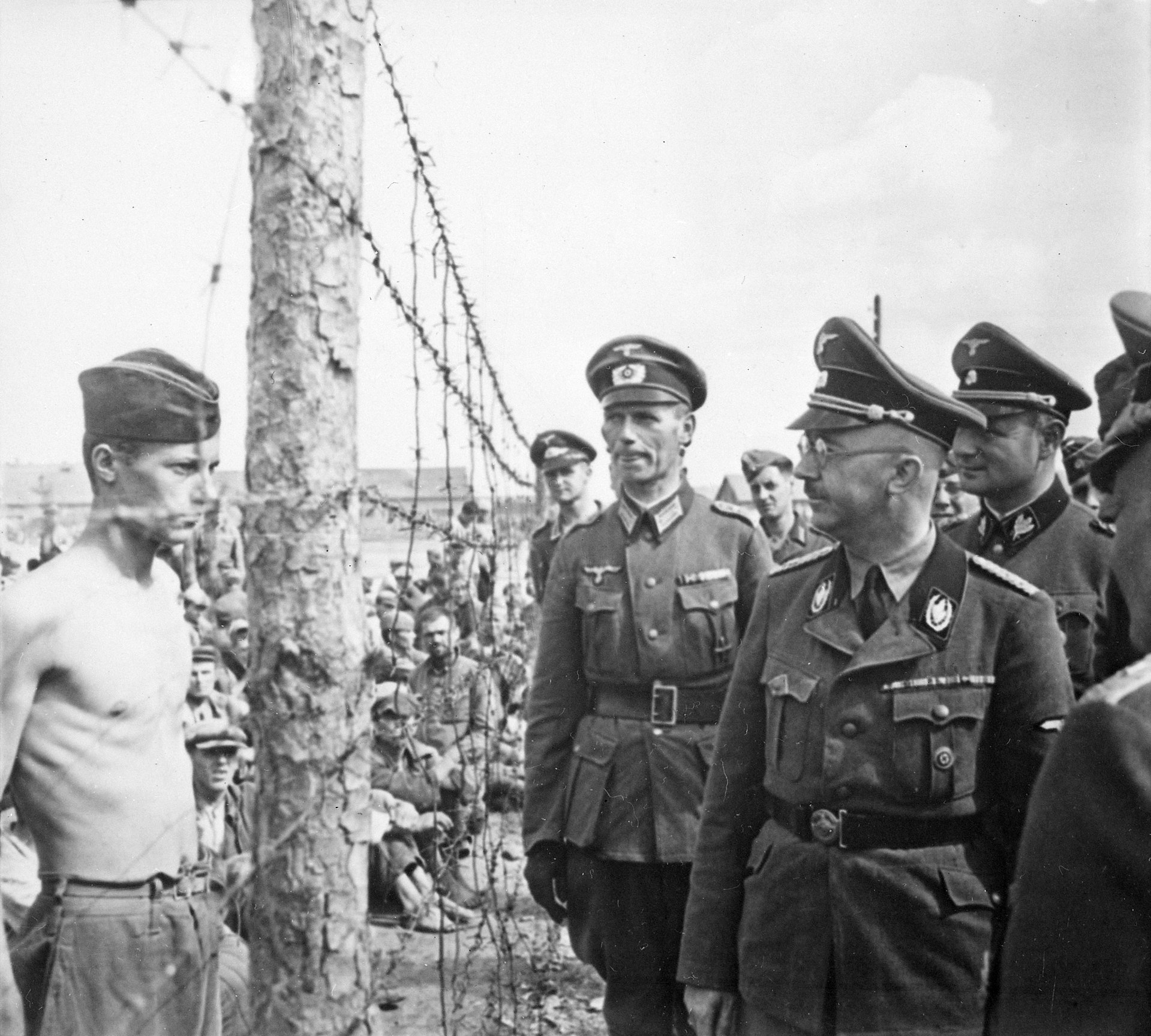
Himmler, Ernst
Kaltenbrunner, and other SS officials visiting Mauthausen concentration
camp in 1941/ Himmler inspects a prisoner of war camp in Russia, c. 1941
ヒムラーやSDのハイドリヒは、ルーマニアの「鉄衛 団」を支持していたが、「鉄衛団」は1941年1月に統治者イオン・アントネスクに対して反乱を起こす。ヒトラーや外相ヨアヒム・フォン・リッベントロッ プはアントネスクを支持したが、SDはなおも「鉄衛団」を擁護し、ホリア・シマ以下その幹部を救出している。この一件はヒトラーの怒りに触れ、現地のSD 将校は処分された。リッベントロップはこれをSSの勢力拡大を止める好機と見て1941年8月9日にヒムラーに協定を結ばせ、国家保安本部や警察随行官の 通信文を大使や公使に目を通すことを認めさせ、SDの干渉に歯止めをかけようとした。さらにリッベントロップはSSとかつて敵対したSAの幹部を公使に続 々と任命するようになった。しかしながら戦争が進むにつれて外務省の役割は減っており、リッベントロップがヒムラーやSSの躍進を止めるには至らなかった [129]。
ヒトラーがホロコーストを決意したのは1941年夏 であったと言われる[137][136]。しかしヒトラーの命令を受けて実際にホロコーストを組織したのはヒムラーと親衛隊であった。
1942
正式にユダヤ人絶滅が国家政策として定められたのは 1942年1月20日、国家保安本部長官ハイドリヒがベルリンのヴァン ゼー湖畔の高級住宅地にある邸宅で関係省庁の次官級を集めて行ったヴァンゼー会議で あるとされる。この会議でユダヤ人問題の最終的解決について各官庁の分担範囲を決定したといわれる(一方、アインザッツグルッペンや絶滅収容所でのガス殺 は1941年にはすでに開始されていることから、この会議はゲーリングからユダヤ人問題の最終的解決の委任を受けていたハイドリヒがヒムラーのユダヤ人問 題への口出しをけん制するために開いただけの会議であるなどという説もある[140]。ちなみに会議の出席者アイヒマンもこの会議開催にハイドリヒが自分 の権限を誇示するための意味があったことを主張している[141]。
一般的にヒムラーや親衛隊は無差別にユダヤ人を虐殺 していたというイメージが付きまとうが、実際のところはそうではない。親衛隊経済管理本部長官であり、強制収容所運営の責任者であるオズヴァルト・ポール は一貫して強制収容所に移送したユダヤ人の軍需産業への奴隷労働力としての使用を目指していた。労働できる者は絶滅政策の事実上の対象外として、過酷な強 制労働に従事させられた。アウシュヴィッツ所長ルドルフ・ヘスもその回顧録に「アウシュヴィッツへ送られてくるユダヤ人は本来すべて抹殺されるはずであっ たが、ドイツ・ユダヤ人が最初に送られてきた頃にはすでに労働可能な者を選別して収容所の軍需目的に使用するようにという命令が出されていた」と書いてい る[142]。総力戦体制が強まる中、強制収容所の奴隷労働力はナチスにとってますます重要となっていた。ヒムラーは強制収容所の囚人の死亡率を下げるこ とを一貫して命じ続け、親衛隊経済管理本部もそれに努力していた[143]。
一方、「労働不能」とされたユダヤ人は、ナチスに とって全く役に立たないばかりか、既に悪かったドイツの食糧事情をさらに悪化させる厄介な存在であった。そのため即時に絶滅対象とされた。戦時中に行われ たユダヤ人絶滅政策とは基本的に「労働不能」と認定されたユダヤ人の絶滅政策であった[144]。ヒムラーやポールの命令を受けてアウシュヴィッツやマイ ダネク強制収容所でも「労働不能者」(=ガス室送り)と強制労働させる者の選別が行われていた。この選別にあたっては親衛隊軍医が大きな権限を持ち、ヨー ゼフ・メンゲレはその典型として悪名高い[145]。
ヒムラーはヒトラーのユダヤ人絶滅指令について、ふ つうでは耐え難い命令であった、と述べているが[146]、あくまでこれを完遂するつもりであった。し たがって労働に従事させる者もいずれは殺害するつもりであった。1942年秋にはヒムラーが法相オットー・ゲオルク・ティーラックとの会談で「労働を介し た絶滅」という言葉を口にしたことはそれを端的に表していると言えよう[147]。
6月4日、国家保安本部長官兼ベーメン・メーレン保 護領副総督を務めていたハイドリヒは、イギリスが送りこんできたチェコ人暗殺部隊に暗殺された。しばらくはヒムラーが国家保安本部長官職を兼務し、国家保 安本部I局(人事局)局長ブルーノ・シュトレッケンバッハ親衛隊少将を長官代理に任命して国家保安本部長官の実務を担わせていたが、1943年1月からは ヒトラーの同意も得て親衛隊大将エルンスト・カルテンブルンナーを後任に任じた[130]。
駐日ドイツ大使館付警察武官として東京に赴任した ヨーゼフ・マイジンガー親衛隊大佐は、1942年6月にヒムラーの命を帯びて上海に赴いた。マイジンガー大佐は日本に対し、上海におけるユダヤ難民の「処 理」を迫り、以下の3案を提示した。「黄浦江にある廃船にユダヤ人を詰め込み、東シナ海に流した上、撃沈する」、「ユダヤ人を岩塩鉱で強制労働に従事させ る」、「長江河口に収容所を建設し、ユダヤ人を収容して生体実験の材料とする」。しかし日本政府は、悪質なうえに人道にもとるドイツ側の提案を完全に拒絶 した。

Himmler with Indian nationalist Subhas Chandra Bose in 1942
1942年8月、フェリックス・ケルテンの仲介によ
り、ヒムラーはフィンランド訪問し、フィンランド大統領リスト・リチと会見。ケルテンは、リスト・リチに事前にナチのユダヤ人虐殺について報告し、自国の
ユダヤ人の移送を防いだと言われる(→「1938年から1939年のナチ
スドイツによるチベット探検」)。
1943
8月20日、ヒムラーはフリックに代わって内相に就 任、名実ともにドイツ警察の支配者となった
1944
ドイツの戦況悪化とともに国防軍不信に陥ったヒト ラーは、親衛隊に信頼を寄せるようになっていった。1944年2月14日には国防軍情報部(アプヴェーア)部長ヴィルヘルム・カナリス海軍大将が失脚。ヒ トラーはアプヴェーアの機能を国家保安本部第6局(国外諜報 (Ausland-SD) 局長ヴァルター・シェレンベルク)の下に吸収させ、同局の軍事情報部とすることを認めた[148]。7月20日午後0時40分過ぎ、東プロイセン・ラステ ンブルクにあった総統大本営「ヴォルフスシャンツェ」の会議室において、ヒトラーが将校たちと会議中にクラウス・フォン・シュタウフェンベルク参謀大佐 (国内予備軍参謀長)が仕掛けた時限爆弾が爆発した。将校や速記者に死亡者・負傷者が出たが、ヒトラーは軽傷を負うにとどまった(7月20日事件)。この 時ヒムラーは25キロメートル離れたマウルゼー湖畔のSS本部にいたが、午後1時頃に事件を知るとただちにラステンブルクの総統大本営へ急行し、わずか 30分で到着した[149]。ヒムラーは総統大本営に到着後、SS隊員とともに捜査を開始した。会議室から一人姿を消したシュタウフェンベルク大佐が犯人 であると確信し、ベルリンにいたフンベルト・アーハマー=ピフラーダー(ドイツ語版)SS上級大佐にシュタウフェンベルクの逮捕を命令した(しかし、ベン ドラー街へ逮捕に向かったピフラーダーの方が、逆にシュタウフェンベルクらによって身柄を確保されてしまっている)。ヒトラーはシュタウフェンベルクの上 官である国内予備軍司令官フリードリヒ・フロム上級大将も何らかの形で謀反に関わっていると考え、ヒムラーを新たな国内予備軍司令官に任命し、ベルリンへ 行くよう命じた。予備軍とはいえ、ヒムラーは念願の軍司令官の地位を手に入れたことになる[150]。午後5時頃にヒトラーと別れる際に「総統、後のこと は私にお任せください」と述べている[151]。ヒムラーがベルリンに到着した7月 21日明け方にはすでにシュタウフェンベルク大佐ら首謀者はベンドラー 街(ドイツ語版)(国防省)においてフロムの命令で銃殺されており、その遺体は彼の指示で勲章や階級章や軍服などを身に着けたまま軍人として埋葬されてい た。ヒムラーはただちに武装SSを動員してベンドラー街を占拠、シュタウフェンベルク大佐らの遺体を掘り起こさせて勲章などを剥奪すると、火葬のうえ遺灰 は野原にばら撒かせた。ヒムラーは国家保安本部長官エルンスト・カルテンブルンナーに大々的な捜査・逮捕を命じた。彼の指揮の下に捜査が進められ、最終的 に5,000人程が処刑され、数千人が強制収容所へ送られた。「長いナイフの夜」事件以来の大規模な政治犯の逮捕劇となった[152]。ヒムラーは一連の 謀反の最大の鎮圧者となったが、実際は事前に暗殺計画を把握していながら、事件の発生を黙認した可能性も指摘されている[153]。事件直前の7月17 日、ゲシュタポはヒトラー暗殺計画の可能性があり、その容疑者としてカール・ゲルデラーとルートヴィヒ・ベック上級大将の逮捕状を発給するようヒムラーに 求めているが、彼はなぜか拒否している。戦後にSDのある将校は「ヒムラーは表向き引き延ばし戦術をとっていた」と証言している。彼が一旦 実行に移させて から一網打尽にしたほうがよいと判断したのか、それともヒトラー暗殺を期待していたのかは不明だが、いずれにせよこの暗殺計画は失敗に終わり、その後のヒ ムラーはいつも通り反逆者の逮捕・処刑の実行者となった[153]。
国防軍の将校たちが暗殺事件に関与していたことは軍 の地位低下につながった。それは親衛隊が国防軍に対して絶対的な優位を確立したことを意味した。同じ日にヒトラーがヒムラーを国内予備軍司令官に任じたこ とも、このことのだめ押しとなった[154]。予備軍の実務は親衛隊大将ハンス・ユットナーが代行した。また陸軍兵器局が中心に開発してきたV2ロケットの生産・運用も陸軍から親衛隊経済管理本部の手に 移っている。
1944年12月2日にヒムラーはオーバーライン軍
集団司令官に就任し、西部戦線で指揮を執ることとなった。ヒムラーのオーバーライン軍集団はシュトラースブルクまで数キロまで迫ったが、結局アメリカ軍の
反撃にあってライン川の向こうへ撃退された。
1945
ヒトラーはオーバーライン軍集団でのヒムラーの指揮
を評価し、1945年1月23日にヒムラーを東部戦線のヴァイクセル軍集団司令官に任じた。参謀総長ハインツ・グデーリアン上級大将はこの人事に反対した
が、ヒトラーは強行した。ヒムラーは今度こそ戦勝報告をヒトラーにもたらそうと張り切り、予備軍や武装親衛隊の残存兵力をかき集め、また、フェリックス・
シュタイナーをはじめとする有能な武装親衛隊将校を招集した。ドイツ本土に迫るソ連軍を迎え撃つが、すでにドイツ軍は消耗しきっており、しかも部隊指揮経
験を持たないヒムラーはまともな作戦指揮ができなかったため、ソ連軍にオーデル川を突破された。グデーリアンはヒムラー降ろしを急ぎ、結局、最後にはヒト
ラーも司令官の首を挿げ替えることに同意し、1945年3月20日、同軍集団の司令官職は陸軍大将ゴットハルト・ハインリツィに替えられた。この件でヒム
ラーの権威は大きく傷ついた[155]。
シェレンベルクの斡旋で1945年2月19日、訪独したスウェーデン赤十字社のフォルケ・ベルナドッテ伯爵とヒムラーは、入院していたホーエンリューヒェ
ン療養所(ドイツ語版)において初めて会見した。ベルナドッテは米英との和平のためには強制収容所の囚人の解放がよいと薦め、まずスカンディナヴィア系の
強制収容所抑留者をスウェーデンに引き渡してほしいと求めた。しかしこの時ヒムラーは「もしその要求に応じたら、スウェーデンの新聞はでかでかと書くで
しょうね。"戦犯ヒムラー、最後の土壇場で責任逃れ。今から免罪対策"とね。」と述べて拒否した[157]。しかしその後さらに戦況が悪化し、ヒムラーは
ついにアメリカとイギリスに対しては降伏しても構わないという心境に至り、米英軍とドイツ軍の残存兵力でもって協力してソ連と戦うことを望んだ。4月2日
にヒムラーは再度ベルナドッテと面会した。ヒムラーは西部戦線における条件付き降伏を米英に提案してくれないかと求めた。ベルナドッテは「ヒムラーがヒト
ラーの後継者を名乗ること。ナチスを解体させて党員を配置換えすること。スカンディナヴィア系の強制収容所抑留者を釈放すること」などを条件として求め、
ヒムラーはこれに応じた。その後もヒムラーとベルナドッテは4月20日と4月24日に面会して米英に対しての降伏に向けた調整を続けた[158]
[159]。
1945年4月20日、最後の総統誕生日にヒムラー はベルリンの総統地下壕に入り、ヒトラーと面会した。しかし憔悴したヒトラーにはすでに期待しておらず、早々に地下壕を出ると、部分降伏に向けた工作を再 開した。4月21日午前2時、ケルステンの地所でシェレンベルクとともにアメリカ政財界に強い影響力を持つ世界ユダヤ人会議の特使ノルベルト・マズーア (ドイツ語版)と極秘に面会し、アメリカ政府への執り成しを求めた。ヒムラーはマズーアに「君たちユダヤ人と我々国家社会主義者は共に争いの斧を降ろす時 である」などと述べた。マズーアは親衛隊の側が一方的にユダヤ人に斧を振り降ろしていたにも関わらず何という言い草だと思いつつ、それでもいくらかの同胞 の命を救うことができるかもしれないと考えてヒムラーとの交渉を続けた。マズーアはスイスかスウェーデンに向かうことができる場所の強制収容所に収容され ているユダヤ人については速やかに解放すること、それ以外の場所の強制収容所に入れられているユダヤ人についてはその強制収容所を無抵抗で連合軍に明け渡 すまで人間的な待遇を与えることを条件として提示した。ヒムラーはそれを了承した[160]。
ベルナドッテはアメリカ政府にヒムラーの西部戦線降
伏提案を伝えていたが、4月29日、アメリカの大統領トルーマンは「部分降伏はありえず」として、正式に提案の拒絶を発表し[161]、ヒムラーは落胆し
た。しかもこの彼の活動は1945年4月28日、BBCのラジオ放送によって「無条件降伏を申し出た」という旨で暴露され、やがてヒトラーの知るところと
なる[162]。
ベルナドッテはアメリカ政府にヒムラーの西部戦線降
伏提案を伝えていたが、4月29日、アメリカの大統領トルーマンは「部分降伏はありえず」として、正式に提案の拒絶を発表し[161]、ヒムラーは落胆し
た。しかもこの彼の活動は1945年4月28日、BBCのラジオ放送によって「無条件降伏を申し出た」という旨で暴露され、やがてヒトラーの知るところと
なる[162]。
ヒムラーは、イギリス軍の一兵卒の捕虜への粗末な扱
いに耐えられなくなり、収容所所長に対して「私はハインリヒ・ヒムラーだ」と名乗った。さらに連合軍上層部との政治的交渉を求めた。所長は上層部に取り計
らってみると回答したが、結局交渉は拒否された。翌5月23日、ヒムラーの身体検査が行われた。イギリス軍のエドウィン・オースティン曹長がヒムラーに長
椅子を指して「これがあなたの寝台だ。服を脱ぎなさい」と全裸になることを要求したが、これに対してヒムラーは「君は私が誰だか分かっているのかね」など
と述べた。オースティンは「あなたはハインリヒ・ヒムラーだ。そしてこれがあなたの寝台だ。服を脱ぎなさい」と再度全裸になることを要求した。ヒムラーと
オースティンはしばらくじっと睨みあっていたが、先に目を逸らしたのはヒムラーの方だった。彼はおとなしく服を脱ぎはじめた[166]。軍医がヒムラーの
身体を調べ、口の中を調べようと指を入れた時、ヒムラーは軍医の指にかみついた。そして奥歯に隠し持っていたシアン化カリウムのカプセルを噛み砕き倒れ
た。その場にいたイギリス軍兵士たちはすぐにヒムラーの身体を逆さにして毒を吐き出させようとした。ついで糸と針で舌を固定して催吐剤を使用して胃液を吐
きださせようとしたが、約12分間苦しんだ後に死亡した[167]。自殺を防げなかった軍医は直後に「やられた」と口にしたという[166]。イギリス軍
はヒムラーの遺体の写真を撮り、さらにデスマスクを作った後、彼の頭を切開して脳の一片を切り取って保存した[168]。遺体は1日放置され、イギリス軍
の報告を受けて到着したアメリカ軍とソ連軍の士官の検死を受けた後、リューネブルクの森に埋められた[169][167]。埋葬後に墓石等は与えられな
かったため、森のどこに埋められているのかは不明である[167]。
+++
Links
リンク
文献
その他の情報



Copyleft,
CC, Mitzub'ixi Quq Chi'j, 1996-2099